How Much Does It Cost To Build An MVP

An MVP (Minimum Viable Product) is a simplified version of a product designed for easy customer use. It allows users to help themselves, discover the product on their own, and start using it with minimal guidance.
If you’re building a new product, launching a startup, or testing a fresh idea, you’ve probably heard the term MVP (Minimum Viable Product). It’s a smart way to launch fast, learn what works, and avoid wasting time or money.
Turning your idea into a real product feels amazing, and making money from it is even better.
Building an MVP is the smartest way to turn your startup idea into a real product without wasting time or money. This guide explains how much it costs to build an MVP, what factors affect the budget, and how Ontik Technology helps founders launch fast with clarity and confidence.
At Ontik Technology, we work with startups across every stage of the MVP journey. Whether you’re just validating an idea, upgrading a rough prototype, or preparing to scale your product, this guide shows exactly how we help you get there.
Why is Budget Planning Essential for MVP Development?
An MVP (Minimum Viable Product) a is the first step for startup founders, and businesses to test a new idea. It allows them to build a lean, workable version of their digital product to check if it works without spending too much time or money.
This approach is ideal for new businesses still shaping their core idea or for teams looking to add new features but unsure how users will respond.
With an MVP startups, founders, and businesses can get real feedback early, fix issues before they grow, and avoid wasting money and time on something people don’t want. Before you build your digital product or MVP, you need to plan or calculate how much it costs to build an MVP.
Many people ask, "How much does an MVP cost?" The answer depends on your idea, features, design, and the team you choose. If you are building a software business, understanding the SaaS MVP development cost is important. Even if you use low code tools, you still need to know the low code MVP development cost. Planning your budget helps you pick only the most needed features. This way, you can reduce MVP development costs and launch your product faster. It also helps you understand the MVP app development cost, MVP prototype cost, and the full cost of MVP development.
Knowing the cost of developing an MVP is an indication that you're serious and well prepared when speaking with investors. That's why you should have a well defined plan in place, whether you are discussing how much does MVP cost or how much does MVP software development cost.
Ontik Technology focuses on helping visionary founders, early stage teams, and startup builders bring their ideas to life through meaningful MVP solutions. Our services are ideal for:
| Startup Type | Description | Goal |
|---|---|---|
| Idea-Stage Founder | Just getting started, still validating the core concept | Clarify your direction, test user interest, and prepare a prototype or lean MVP |
| MVP Builder / Upgrader | You have a clear product roadmap or an early version | Build a robust MVP or improve what you already have |
| Launch-Ready Startup | Your MVP is stable, and you're ready to launch or scale | Improve tech readiness, infrastructure, and prepare for growth |
How Much Does It Cost To Build An MVP (Minimum Viable Product)
Here’s a simple breakdown of the cost to build an MVP based on real startup situations. From idea research to support after launch, every step has its own cost and matters a lot. If you know the early stages, that can help you plan and avoid burning money.
Various elements or factors can affect MVP development cost as in how complex your app is, how skilled your developers and team members are, and how much time it takes to launch your MVP product. There are lots of parts involved here, like frontend design, backend work, third party tools, and product testing costs, which can increase your MVP cost. If you want something quicker and more affordable, low code MVP development cost options are available, but they may not scale well in the future.
If you're wondering how much does it cost to develop an MVP, the usual cost is between $15,000 and $50,000, based on how advanced your idea is. But it’s not just about the price, it’s about smart planning. Startups should try to reduce MVP development costs by choosing the right team.
🟢 Note: Ontik Technology is one of the top choices for MVP product development. They offer clear pricing, fast delivery, and trusted MVP development services for startup companies. Whether you’re building a mobile app or an SaaS MVP, Ontik helps you build an MVP quickly and efficiently.
Core Cost Component of MVP products Development
| Pre-MVP Development Phase | Description | Estimated Cost Range (USD) | Importance Level | Tips to Reduce Cost |
|---|---|---|---|---|
| Research and development phase | Research, planning, and product requirement setup | $1,000 – $5,000 | High | Use the lean canvas model |
| Development Cost of MVP | Complete coding and development process | $8,000 – $20,000 | Very High | Use an experienced offshore team |
| Front-End Development | User interface and experience design | $3,000 – $7,000 | High | Start with basic UI components |
| Backend Development | Business logic and server setup | $4,000 – $10,000 | Very High | Use scalable backend frameworks |
| Database Setup | Data storage, schema design, and security | $1,000 – $3,000 | Medium | Use cloud based DB solutions |
| Third Party Integrations | Integrating APIs and external tools | $1,500 – $5,000 | Medium | Choose only essential integrations |
| Testing and Quality Assurance | Bug fixes, QA, and usability testing | $2,000 – $5,000 | High | Use automation tools for testing |
| Post-MVP Development Phase | Description | Average Cost Estimate (USD) | Startup Tip |
|---|---|---|---|
| Maintenance & Updates | Regular updates to ensure smooth performance and compatibility with the latest OS | $1,000 – $5,000/year | Use automated testing to reduce update costs |
| Bug Fixes | Fixing bugs reported by users post launch | $500 – $2,000/month | Prioritize critical bugs to save time |
| Customer Support | Ongoing support to respond to user queries and technical issues | $500 – $1,500/month | Use chatbot based support initially |
| Server & Hosting Costs | Costs for keeping the app live, including cloud hosting and server usage | $1,000 – $3,000/year | Choose scalable, pay as you go hosting |
| Performance Monitoring | Tools and services to monitor real-time app performance and user activity | $500 – $1,000/year | Start with free tools like Google Analytics |
| User Feedback Analysis | Collecting and analyzing user feedback to plan future features or changes | $200 – $500/month | Run surveys using free platforms |
| Marketing & Launch Campaigns | Marketing efforts to promote the app through launch emails, social media ads, etc. | $2,000 – $10,000 | Use low budget social media ads first |
| Analytics & Reporting Tools | Using tools like Mixpanel or Firebase for a better understanding of user behavior | $500 – $2,000/year | Start with free tiers of analytics tools |
| App Store Optimization (ASO) | Improving app visibility in app stores through keyword targeting and better descriptions | $200 – $1,000 | Use keyword tools like Ubersuggest |
| Scalability | Enhancing system capacity to handle more users and requests efficiently | $1,000 – $5,000 | Use modular code |
| Improvements | Handle more users and requests efficiently | $5,000 | For easier scaling |
Workflow Breakdown of MVP Development
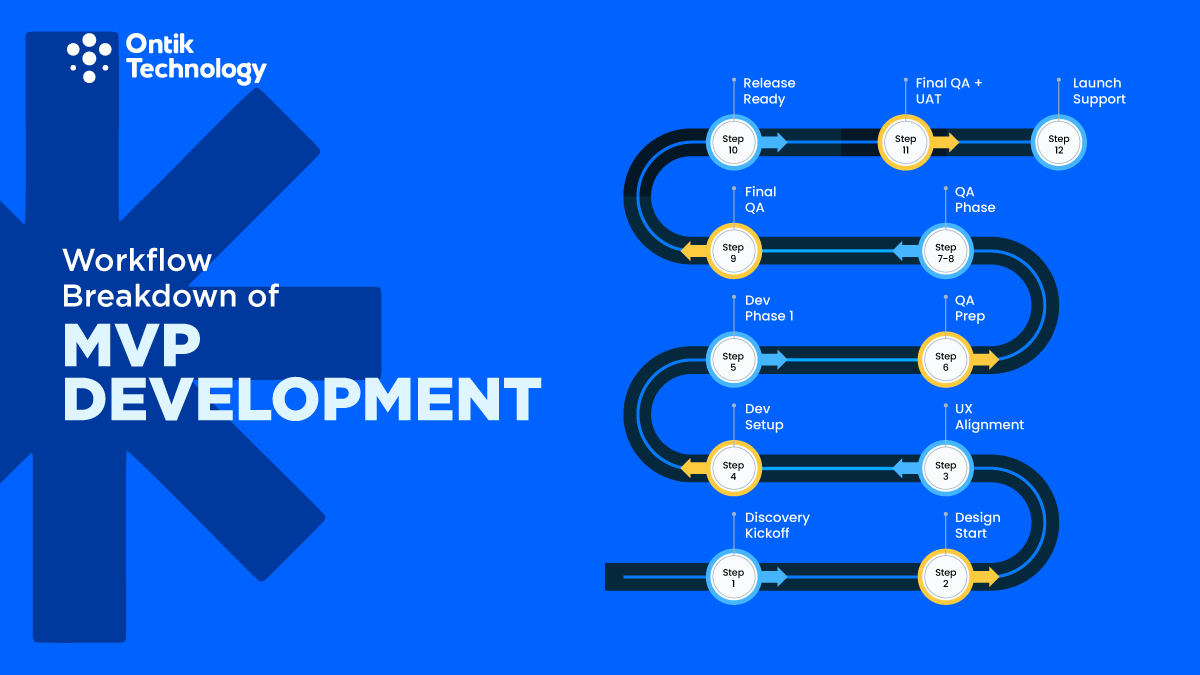
Here is the workflow breakdown of MVP product development:
Step 1: Discovery Kickoff
- Stakeholder session to understand the vision
- Define product goals and user needs
- Finalize scope and roadmap
Step 2: Design Start
- Deliver Figma flows and user stories
- Set up task board in Jira or ClickUp
- Begin user experience design
Step 3: UX Alignment
- Review feedback on designs
- Refine UI and UX scope
- Lock core user journeys
Step 4: Dev Setup
- Start with user management module
- Prepare base architecture
- Deliver first internal demo
Step 5: Dev Phase 1
- Build core product features
- Create 2nd demo with flows working
- Track progress with weekly updates
Step 6: QA Prep
- Reach 50% code completion
- Start writing test cases
- Prepare for functional testing
Steps 7–8: QA Phase
- Run regression testing
- Fix bugs and improve usability
- Handle minor scope additions
Step 9: Final QA
- Freeze the code
- Polish the product experience
- Prepare for deployment
Step 10: Release Ready
- MVP is now deployable
- Complete all documentation
- Handoff for internal review
Step 11: Final QA + UAT
- User Acceptance Testing with 90–100% test case coverage
- Create a user guide and support docs
Step 12: Launch Support
- Sign off from team or client
- Final code handoff
- Internal training and post-launch prep
Hour and Time Cost Breakdown of MVP
Ontik follows a structured timeline approach for MVP delivery based on your startup stage.
- For idea stage founders, the process takes around 4 to 6 weeks
- For startups building or upgrading an MVP, it takes 8 to 12 weeks
- For launch ready startups needing scale or polish, it takes 6 to 16 weeks
There's also a sample 12-week breakdown showing each weekly activity like discovery kickoff, design, development, testing, QA, and launch support. This makes it easier to track time spent across different phases and align resources at each step.
People and Developer Cost Breakdown of MVP
Each stage of MVP development involves different experts to keep quality high and delivery fast. Ontik assigns dedicated professionals depending on your MVP type:
Idea Stage MVP
- Product Strategist
- UI UX Designer
- No Code Developer (if needed)
- Business Analyst
MVP Builder or Upgrader
- Product Manager
- UI UX Designer
- Frontend and Backend Developers
- QA Engineer
- DevOps (if needed)
Launch Ready MVP
- Senior Developer or Architect
- DevOps Engineer
- QA Lead
- Automation Specialist
- Technical Project Manager
This team setup shows the human cost involved in combining strategy, design, development, and QA to deliver a complete MVP.
Cloud Hosting Options for MVPs
Choosing the right cloud hosting is very important when building an MVP. It helps your product run well, grow easily, and stay within budget. Cloud hosting gives you flexibility, saves money, and lets you launch faster without spending too much. Here in this table, we can show the three most renowned cloud provider and their overviews, processes, pricing rates, and key features:
| Cloud Provider | Overview and Process | Pricing Rates | Key Features |
|---|---|---|---|
| AWS | AWS (Amazon Web Services) is widely adopted for startups and MVPs. It offers on demand cloud resources, elastic scalability, and easy setup using services like EC2, S3, and Elastic Beanstalk. The process involves selecting services, setting up an instance, and scaling as needed. | Free tier available (EC2 750 hours/month for 12 months). After free tier: $8–$12/month for t2.micro instances. S3 storage starts at $0.023 per GB. Lambda offers 1M free requests then $0.20 per million. | Global reach, strong documentation, 200+ services, flexible pricing, mature ecosystem, secure and scalable infrastructure. |
| Azure | Azure is Microsoft’s cloud platform, integrated deeply with Windows and Office tools. Ideal for teams already using Microsoft products. MVP hosting starts with services like App Service, Azure DevOps, and Azure SQL. Easy to deploy using Visual Studio or GitHub workflows. | Free tier includes 12 months of BIS VM (750 hours/month). Basic Linux VM from $13/month. Azure Blob Storage starts at $0.0184/GB. App Service starts at $0.013/hour. | Best for Windows environments, seamless Office integration, enterprise grade compliance, hybrid cloud capabilities, strong analytics tools. |
| Google Cloud | Google Cloud is known for simplicity, speed, and strong AI integrations. Developers often use Firebase for MVPs. Setup includes using Google Compute Engine, Firebase Hosting, or App Engine. It works well for mobile apps and real time features. | Always Free tier includes Firebase Hosting, 5GB storage, and 1GB bandwidth. Compute Engine micro VM starts at $6/month. Cloud Functions: 2M invocations free, then $0.40/million. | Fast setup, cost effective, built in AI and ML tools, Firebase integration, excellent for mobile apps and real time use cases. |
Factors Influencing the MVP Development Cost
If you're a startup founder planning to build your first minimum viable product (MVP), one big question is: How much does it cost to build an MVP? The answer depends on many things from your product idea to your team setup. Here’s a detailed look at the real factors that influence the MVP development cost, especially for startups.
- Project Complexity & Features
The more features you want in your minimum viable product, the higher the MVP development cost. A simple MVP with core functions is cheaper, while advanced AI or SaaS features increase the cost of MVP development.
- Team Location & Hiring Model
Team location matters for building MVP products. The cost to develop MVP can vary based on which country the developers are in, how skilled they are, and where your development team is located. There are 3 hiring models: offshore, nearshore, and onshore. Hiring offshore developers from Asian countries helps reduce MVP development cost while still delivering high quality products and services at a much lower price than U.S. based options.
- Three Development Approaches: No-code, Low-code, or Custom
There are three approaches available. If you're wondering how much does it cost to develop an MVP, it can vary based on your approach. No-code tools like Retool and Bubble can lower costs, rather than preparing custom coded MVP products. Low-code MVP development costs are usually lower, but they may not be scalable. Custom software development costs more but allows more control and growth.
- Different Platform Types: Web, iOS, Android
MVP cost can vary based on different factors, and it depends on your requirements, like whether you’re building for a single platform or multiple ones. A web app is more budget friendly, whereas developing for iOS and Android increases your MVP app cost.
- Design Needs: UI/UX Simplicity vs. Detail
Sleek and modern UI/UX design can improve user retention, but it adds to the cost to build MVP. Custom visuals, animations, and prototypes raise the MVP prototype cost.
- Technology Stack
Your chosen tools and frameworks affect the development cost of MVP. Some tech stacks take more time to consume, which increases both development time and the overall MVP cost.
- Team Structure: In-house vs. Outsourced
Having an in-house development team gives full control but raises the MVP development budget due to salaries and overheads. Outsourcing to MVP development services or agencies offers flexibility and a lower average cost.
- Post Launch Support
The cost of MVP software development isn’t just about building it. It includes support, updates, and improvements. Make sure your MVP development process includes post Launch maintenance in the cost estimate.
Convert Your Business Idea into Reality with Ontik Technology’s MVP Development Services
1. From Idea to Impact Start with an MVP
Building a complete app at once takes time and money. Ontik helps you start small with a clear MVP that lets you test real users early. This lowers your mvp development cost while proving your idea fast.
2. Clear and Honest Pricing
Not sure how much does it cost to develop an MVP? We offer fixed pricing and transparent scope, so you get clarity from day one from mvp prototype cost to a full launch plan.
3. Fast Delivery Without Quality Loss
Our team focuses on fast delivery. You get your MVP within 9 to 12 weeks so you can move forward quickly without sacrificing quality.
4. Full MVP App Development Support
From planning to launch, we handle the entire process. Whether it's a mobile app, SaaS MVP, or low-code MVP, our roadmap shows you exactly what to do and when to do it.
5. Scalable and Future Ready Solutions
We help you build an MVP that grows with your users. Our post MVP support and scaling lets you improve and expand without starting over keeping your long term costs low.
6. Skilled In-House and Offshore Teams
You choose how to work with our dedicated product and tech team or a flexible offshore setup. Either way, we give you quality, control, and cost balance.
7. Trusted SaaS MVP Development Cost Models
For SaaS founders, our SaaS MVP development cost plans are built to match your product roadmap and business goals.
8. Maximize Efficiency, Minimize MVP Costs
Our strong UX and dev execution means we use smart tools, reusable code, and automation to build fast and reduce waste keeping your MVP development costs down.
9. Industry Trusted MVP Development Services
We are trusted by real startups who choose us for MVP development services. From design to launch, we give you solid results with a clear timeline and proven delivery.
10. Partner with a Proven MVP Expert
Ontik is not just a builder we are your partner. We help you design, budget, and deliver your MVP with confidence and support your growth from day one.
Why Founders Choose Ontik To Build an MVP
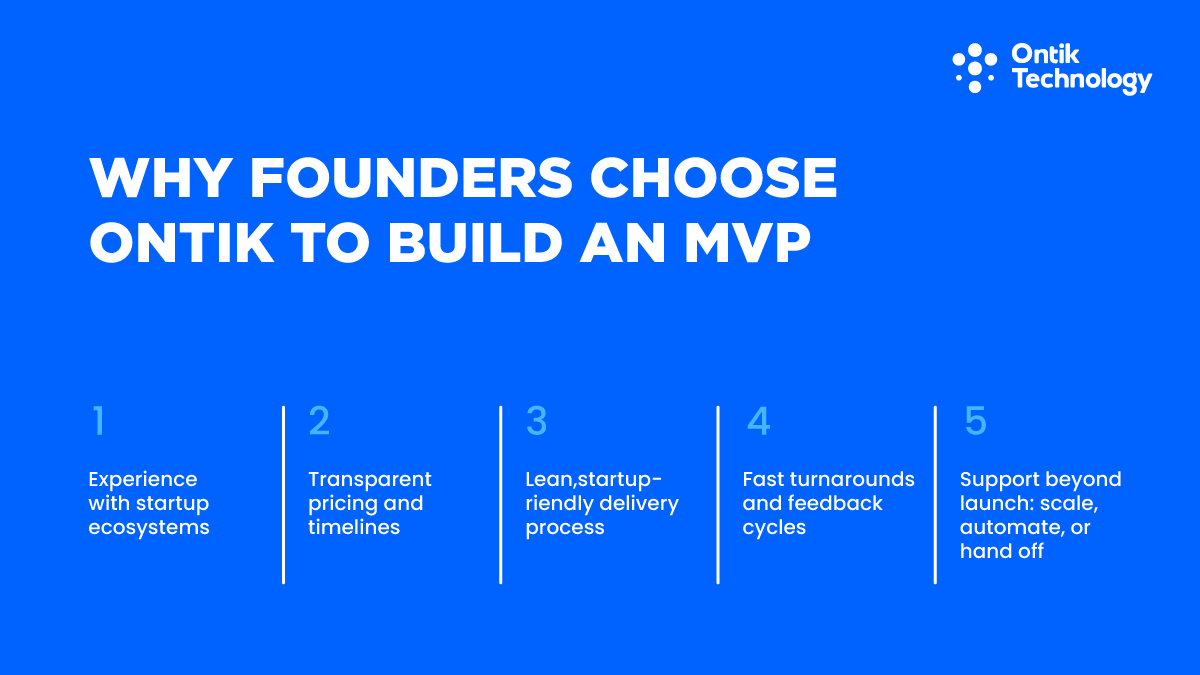
Why Founders Choose Ontik To Build an MVP Product
- Experience with startup ecosystems
- Transparent pricing and timelines
- Lean, startup-friendly delivery process
- Fast turnarounds and feedback cycles
- Support beyond launch: scale, automate, or hand off
Final Thoughts
Building an MVP product or digital solution is one of the smartest first steps for any startup. It allows founders to test their ideas, scale their business, and achieve a high return on investment (ROI). In today’s world, building an MVP quickly is possible. You just need to choose the right and experienced team that specializes in MVP or SaaS product development.
This article covers everything you need to know: a full MVP cost breakdown, key factors that influence development costs, and how to plan your MVP development budget wisely. An MVP lets you launch smarter, test early, and grow faster. With the right team like Ontik, you can keep costs low, build what users need, and move from idea to success in your business.

We’re the storytellers behind Ontik Tech crafting clear, insightful, and strategy driven content that connects with our audience and drives real results.
Explore Our Latest Blogs & Industry Insights

Outsourcing software development has become a cornerstone strategy for businesses of all sizes, from startups to large enterprises. One of the most effective strategies to achieve this is by outsourcing software development to specialized IT firms. By partnering with top-notch outsourcing companies, businesses can tap into global expertise, streamline operations, and accelerate their time-to-market, all while keeping costs in check. Whether you’re a startup aiming to disrupt the market or an established enterprise looking to scale, choosing the right IT outsourcing partner can be the game-changer that propels your business to new heights. In this article, we’ll explore the top 25 best IT Software Development Outsourcing Companies that are setting the industry standard, delivering cutting-edge solutions, and helping businesses worldwide achieve their goals.
List of Top 25 Best IT Software Development Outsourcing Companies

These top 25 global Outsourcing Software Development Companies are renowned for their diverse and highly skilled teams, boasting expertise in various IT industries.
| S/N | Outsourcing software development companies | Country | Services | Google Ratings | Client Review |
|---|---|---|---|---|---|
| 1 | Ontik Technology | Bangladesh | Outsourcing software development, Dedicated Development Team, Team Augmentation, Outsourced MVP Development Service, Integrated Business Automation, Custom Software Development | 4.5 | Ontik Technology set up our full development team in just 2 weeks! We're already on track to finish our development after just a few months! - Eli Muse, Founder and CEO of Chippit. |
| 2 | Purrweb | UAE | offshore outsourcing software development, web, and mobile app development, software development outsourcing and outstaffing, UI/UX design, quality assurance testing, project management, analytics, DevOps | 4.9 | The company exhibited exceptional skills and professionalism. |
| 3 | SumatoSoft | USA | offshore outsourcing software development, web development, IoT development, software development services, UI/UX design | 4.8 | Their full transparency in communication and operations impressed us the most. |
| 4 | Netcorp Software Development | Tallinn, Harju | IT outsourcing services, including custom web development, mobile app development (iOS, Android, and cross-platform), enterprise software solutions, and IT consulting | 5.0 ( clutch) | Whenever we had any requests or concerns, their team responded to us within 24 hours. |
| 5 | Saigon Technology | Vietnam | web development, Agile software development outsourcing, UI/UX design, outsourcing software development Service | 4.6 | Their professionalism and commitment to customer satisfaction are commendable. |
| 6 | Arcanys | Philippines | software outsourcing development, UI/UX design, quality assurance testing, outsourcing software development Service | 4.9 | They are great professionals and have helped us to continue delivering software on time and without problems. |
| 7 | Aalpha | India | web development, mobile app development, UI/UX design, Python development, software development outsourcing service | 4.9 | They deliver a higher work quality than other companies and within the desired timeframes — we really appreciate that. |
| 8 | e-Zest | India | consulting, web app development, UI/UX design, quality assurance testing, software development outsourcing service | 4.7 | Very interactive people and staff. Speedy HR process. They can go at any limit to get deserving candidates. |
| 9 | BairesDev | USA | web development, mobile app development, UI/UX design, Python development, software development outsourcing service | 4.9 | They always had something solid and impressive to show. |
| 10 | Tvisha | India | Outsource software development service, Mobile app development, web app development, DevOps, website development, cloud computing | 4.6 | The management team was with me until my project was finished. |
| 11 | PixelCrayons | India | Outsource software development service, web development, mobile app development, CMS development, IT consulting | 4.9 | The most impressive part of the company was the quality of the service they provided. |
| 12 | Infopulse | Poland | web development, mobile app development, software development outsourcing service | 4.7 | The project was finished on time and according to the product roadmap. |
| 13 | Innowise | Poland | web development, mobile app development, UI/UX design, quality assurance testing, project management, software development outsourcing service | 4.8 | Innowise has saved me from possible failure by jumping in quickly and helping me address a gap in my capabilities. |
| 14 | Designveloper | Vietnam | web development, mobile app development, UI/UX design, brand identity design | 4.9 | Their ability to scale easily without sacrificing performance or product quality stands out. |
| 15 | Glorium Technologies | USA | web development, mobile app development, UI/UX design, quality assurance testing, project management, analytics, DevOps | 4.8 | Their dedication to understanding our goals and the needs of our patients was evident from the start. |
| 16 | Syberry | USA | web development, mobile app development, quality assurance testing, project management, outsourcing software development | 5 | The overall structure and organization of their development team is incredibly impressive. |
| 17 | DockYard | USA | web development, mobile app development, UI/UX design, outsourced software development Service | 5 | We made changes during the project, but we still hit our timeline and the cost didn’t increase. |
| 18 | Appetiser | Australia | Web and Mobile App Development, UI/UX Design | 4.8 | The quality of the designs and end product are exceptional! Would highly recommend Appetiser. |
| 19 | Oxagile | USA | web development, mobile app development, DevOps, outsourced Custom Software Development Service | 4.9 | The team goes above and beyond to ensure that both deadlines and product requirements are met. |
| 20 | Intellias | Poland | web development, mobile app development, IoT, AI, Blockchain, IT outsourcing software development | 4.9 | We’ve really enjoyed working with them; they’ve been kind, reliable, and available partners. |
| 21 | Quema | Estonia | web development, mobile app development, UI/UX design, DevOps, IT outsourcing software development | 5 | Quema OU quickly figured out our issues and delivered accurate and professional solutions to our tactical problems. |
| 22 | Adastra | Canada | IT outsourcing software development, web development, Cloud integrations, AI integrations | 4.9 | They ensure the high availability of our infrastructure and 24/7 incident management. |
| 23 | Gippshost | Australia | Outsourcing software development, cloud management, cybersecurity, software outsourcing services, IT outsourcing software development | 4.6 | Innovative approach, robust security. |
| 24 | Dotsquares | UK | web development, mobile app development, Cloud app development, CRM consulting, offshore outsourcing software development | 4.5 | Their proactive advice and collaborative approach add significant value to the positive outcome of the new website. |
| 25 | Accedia | Bulgaria | web development, mobile app development, Cloud app development, AI integration, offshore outsourcing software development | 4.7 | Their dedication is visible in their work and the administrative work-related processes. |
1. Ontik Technology: A Leading Outsourcing Software Development Company
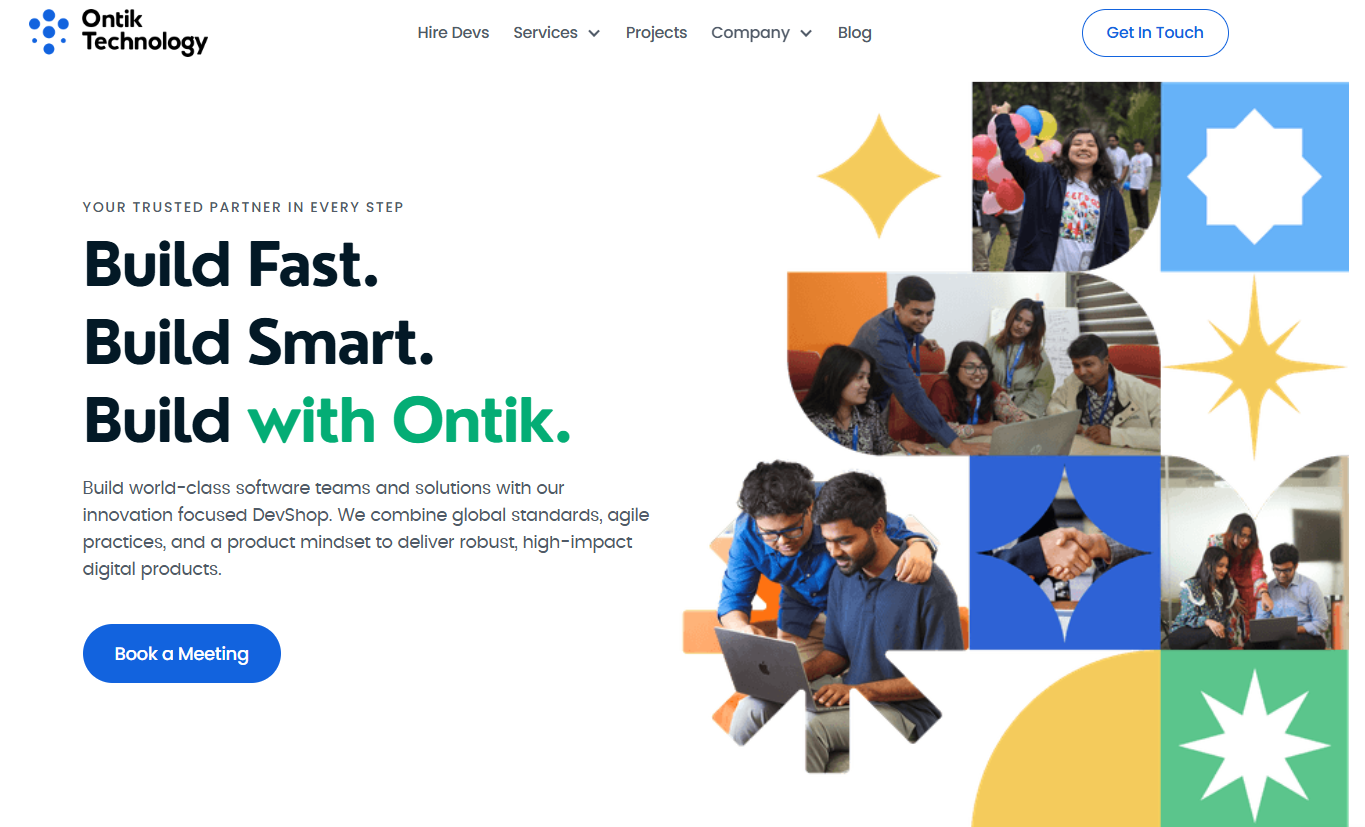
Website: https://ontiktechnology.com/
Category: Custom Software, MVP Design, AI/ML Services, Mobile App design & Development
Ontik Technology is a leading offshore Software Development Outsourcing company. The company is known for its agile approach and quick team setups, making it a top choice for startups and large companies looking for cost-effective outsourcing solutions. Their expertise spans various technologies, ensuring high-quality and scalable software products.
Ontik Technology stands out as a highly capable staffing outsourcing services company with a strong reputation for developer quality and reliability. As a leading staff augmentation company, Ontik delivers flexible, cost-effective, and performance-driven development teams. With over 220+ successful projects, they’re trusted for outsourcing staffing solutions that go beyond code, they deliver results. They excel on their agile approach which ensures seamless integration with client teams. Thus accelerating delivery without compromising quality. Whether it's a startup or a global enterprise, Ontik fulfills diverse business needs with precision and commitment.
Core Services
- Dedicated dev teams
- MVP prototyping & scaling
- AI/ML app development
- UI/UX consulting
- Web & mobile Applications development
Who They Help
Ontik serves funded startups, fintech ventures, and fast scaling enterprises that require dependable remote staffing solutions tailored to real business needs.
Why Ontik Technology Stands Out
- 220+ projects delivered on time & on budget
- Developer-first hiring with multi-level technical screening
- Certified engineers (Scrum, AWS, GCP, Flutter)
- $25–50/hr rates; Minimum project size $10K
- Agile execution with sprint based delivery
- ISO-compliant security & IP protocols
Developer Credibility Highlights
- Strong in-house development team skilled in full-cycle product delivery
- Dedicated product development team focused on scalable architecture and clean code
- MVP development team experienced in rapid prototyping and market validation
- Specialized AI and ML team building smart, data driven applications
- Cross-functional units blending design, engineering, and strategy for optimal results
- Real-time collaboration with clients via Jira, Slack, GitLab
Recognition
- 4.6 Google Rating
- Featured in top Asian outsourced recruiting solutions lists
- Known for blending innovation with execution speed
- Preferred staffing partner by accelerators and tech incubators
Ontik Technology At A Glance
| Founded | Engineers | Clients | Global Clientele |
|---|---|---|---|
| 2016 | 100+ | 220+ | USA, Australia, UK, Canada, Norway, Finland, Sweden, Dubai |
Successful Projects: Transforming Industries Globally
| Project Name | Project Details |
|---|---|
| Fitmate | A mobile app enabling users to subscribe to a network of gyms in Australia. |
| Onguard | An appointment scheduling app that works without the internet, using SMS instructions, developed in collaboration with Carolina Health. |
| CircleBet | A mobile app integrating social media-driven services for social sports betting. |
| Root Food | ERP development for digital transformation in an FMCG company. |
| CNG Association | ERP development for the trade body of CNG station owners in Bangladesh. |
| Tamim Agro | Custom ERP development for an agro-based enterprise focused on contract farming. |
| Aerolex | A web-based B2B online ticketing and hotel booking software for a UK travel agency. |
| Emkay | Digital transformation through CRM and ERP for a large-scale construction engineering company. |
| Saiyonee | A halal matchmaking web-based platform replacing traditional matchmaking methods. |
| Chippit | A platform that allows users to pool money together for shared financial goals. |
| Checkbox | Web development, UI/UX design, ERP, and e-commerce for a Freecommerce platform with significant revenue growth. |
| BanglaShikhi | BanglaShikhi: Connecting UK expatriates with Bengali tutors, offering personalized language lessons to preserve culture and heritage. |
| InCheckFitness | Incheckfit: A fitness app that creates custom meal plans, tracks your goals, and offers delicious recipes—all to help you hit your health and nutrition targets with ease. |
| GiftalBD | Customized e-commerce development that led to revenue generation and a loyal customer base. |
Our Core Expertise Area
Ontik Technology, is one of the Top IT staff augmentation company, providing you with the skilled professionals you need to complete your team. Whether you're looking for a QA specialist, ReactJS web developer, Android developer, or iOS developer, we have the talent to bridge the gaps in your development team.
As the Best IT Outsourcing Software Development Company, our augmentation services are designed to integrate seamlessly with your existing team, offering flexibility and the precise expertise required to drive your projects forward. By partnering with us or hiring dedicated remote developers, you can quickly scale your team with top-tier talent, ensuring that your project timelines are met without compromising on quality.
Our team of experienced developers excels in building outsourced custom software from the ground up, be it for web or mobile applications. We deliver tailored software solutions in Bangladesh and international markets that meet your business needs. As the Best IT Outsourcing Custom Software Development Company, we ensure that your custom software aligns perfectly with your objectives, providing robust and scalable solutions.
MVP stands for Minimum Viable Product. When tech owners are eager to explore a new product idea, they kick off with the MVP process. This approach allows them to test a simplified version of the product, helping them refine and perfect it before diving into full-scale development. As the Best IT Outsourcing Software Development Company, we help IT startups bring their product ideas to life.
From ideation to execution, our experienced product team guides you through every step of the process, implementing RAD and Agile SCRUM methodologies to ensure continuous integration and development.
At Ontik Technology, you can assemble a dedicated software development team tailored to your project’s specific needs. This team will work exclusively under your project manager, giving you full control over the project while leveraging our specialized expertise. As the Best IT Outsourcing Software Development Company, we offer you the flexibility to build a team that matches your project requirements, ensuring quality and efficiency at every stage.
2. Purrweb: A Top Software Outsourcing Partner

- Website: purrweb.com
- Established: 2014
- Location: UAE
- Employee Size: 200-500
Purrweb is an offshore software outsourcing company that offers a full range of services, including web and mobile app development, UI/UX design, and quality assurance testing. Their ability to handle complex projects with professionalism and expertise makes them a go-to choice for businesses seeking reliable IT outsourcing services.
Prominent Clients:
- Tesla
- IKEA
- Binance
Pricing:
- $50 - $99 per hour
Minimum Project Size:
- $25,000 USD
3. SumatoSoft: One of the Best Software Outsourcing Firm

- Website: sumatosoft.com
- Established: 2012
- Location: USA
- Employee Size: 50-200
SumatoSoft is known for its transparent communication and exceptional offshore outsourcing software development services. With a focus on web development, IoT, and UI/UX design, SumatoSoft delivers high-quality software solutions that meet the specific needs of its clients.
Prominent Clients:
- Toyota
- Reuters
- Uber
Pricing:
- $50 - $99 per hour
Minimum Project Size:
- $10,000 USD
4. Netcorp Software Development: Best Software Development Outsourcing Companies in Eastern Europe
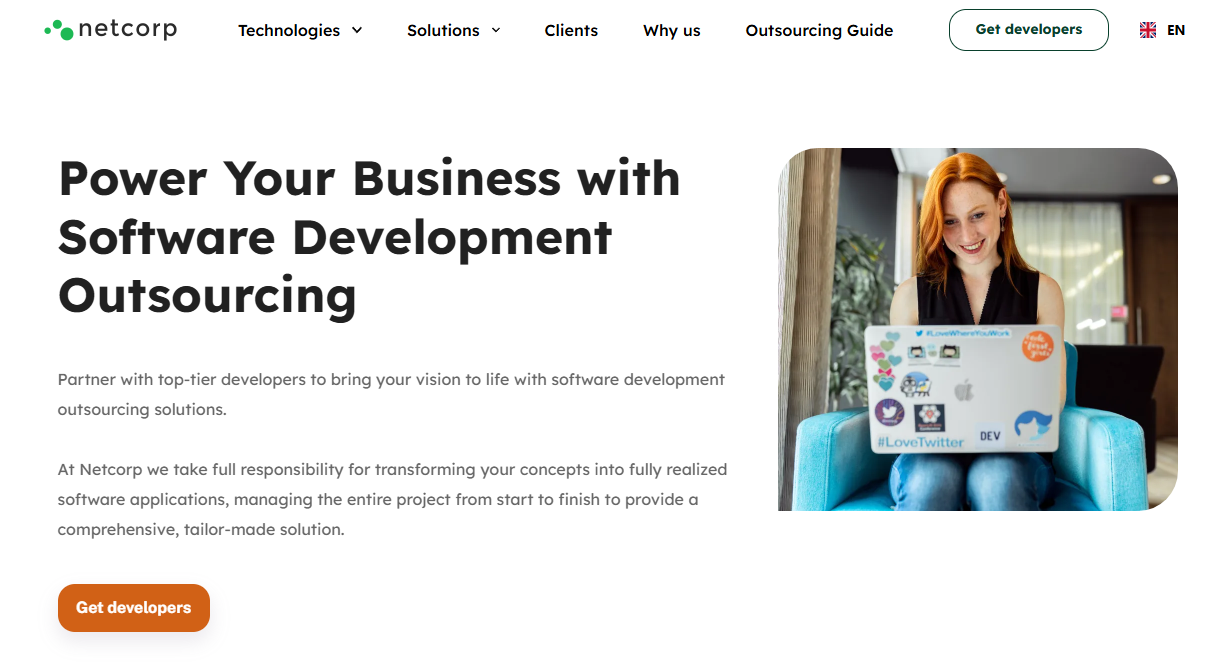
- Website: https://www.netcorpsoftwaredevelopment.com/
- Established: 2011
- Address: Tallinn, Harju
- Employee Size: 50-200
Netcorp Software Development offers a comprehensive range of IT outsourcing services, including custom web development, mobile app development (iOS, Android, and cross-platform), enterprise software solutions, and IT consulting. Their client-focused delivery model, transparent communication, and scalable development teams have positioned Netcorp as a reliable IT outsourcing and software development company for global businesses, earning them strong recognition among the best software development outsourcing companies in Eastern Europe.
Prominent Clients:
- Enterprise and mid-market companies across fintech, healthcare, logistics, and SaaS sectors
- Startups and scale-ups from North America and Europe
Pricing:
- $50 – $99 per hour
Minimum Project Size:
- $25,000 USD
5. Saigon Technology: One of the Best IT Outsourcing Companies

- Website: saigontechnology.com
- Established: 2012
- Location: Vietnam
- Employee Size: 300-500
Saigon Technology is a prominent name in the IT outsourcing industry, known for its expertise in Agile software development and UI/UX design. Their commitment to delivering high-quality solutions and customer satisfaction has made them a preferred partner for many global companies.
Prominent Clients:
- Samsung
- Abbott
- Panasonic
Pricing:
- $25 - $49 per hour
Minimum Project Size:
- $10,000 USD
6. Arcanys: One of the Top Software Development Company

- Website: arcanys.com
- Established: 2010
- Location: Philippines
- Employee Size: 200-500
Arcanys is a leading offshore software outsourcing company that specializes in software development, quality assurance testing, and UI/UX design and landing page design agency. They are known for their ability to deliver projects on time and maintain high standards of quality, making them a reliable partner for startups and established businesses alike.
Prominent Clients:
- SwissRe
- Snap
- Pepperstone
Pricing:
- $25 - $49 per hour
Minimum Project Size:
- $10,000 USD
7. Aalpha: Known for Software Outsourcing Services

- Website: aalpha.net
- Established: 2007
- Location: India
- Employee Size: 100-300
Aalpha is an IT outsourcing software development company that excels in web and mobile app development, Python development, and UI/UX design. They are known for delivering high-quality work within tight deadlines, making them a trusted partner for businesses worldwide.
Prominent Clients:
- World Bank
- Bosch
- Harvard University
Pricing:
- $15 - $25 per hour
Minimum Project Size:
- $5,000 USD
8. E-Zest: Known for Software Outsourcing Services

- Website: e-zest.com
- Established: 2000
- Location: India
- Employee Size: 500-1000
e-Zest is a consulting and outsourcing software development company that offers a wide range of services, including web app development, quality assurance testing, and UI/UX design. Their fast HR process and ability to secure top talent make them a valuable partner for companies looking to outsource custom software development.
Prominent Clients:
- Lufthansa
- Unilever
- Tata Consultancy Services
Pricing:
- $25 - $49 per hour
Minimum Project Size:
- $10,000 USD
9. BairesDev: One of the Top Software Outsourcing Companies

- Website: bairesdev.com
- Established: 2009
- Location: USA
- Employee Size: 1000-5000
BairesDev is a leading IT outsourcing software development company known for its impressive work in web development, mobile app development, and Python development. Their ability to consistently deliver high-quality solutions has earned them a strong reputation in the industry.
Prominent Clients:
- Google
- Rolls Royce
- Urban Outfitters
Pricing:
- $50 - $99 per hour
Minimum Project Size:
- $25,000 USD
10. Tvisha: Leading Software Development Outsourcing Company

- Website: tvisha.com
- Established: 2003
- Location: India
- Employee Size: 100-300
Tvisha offers a wide range of Top IT outsourcing services, including mobile app development, web app development, and DevOps. Their management team's dedication to project success has made them a reliable partner for businesses looking to outsource software development.
Prominent Clients:
- Indian Railways
- LIC India
- Airtel
Pricing:
- $25 - $49 per hour
Minimum Project Size:
- $10,000 USD
11. PixelCrayons: Known for Software Development Services

- Website: pixelcrayons.com
- Established: 2004
- Location: India
- Employee Size: 300-500
PixelCrayons is well-known as one of the best outsourcing software development company that specializes in web development, mobile app development, and CMS development. Their commitment to quality service has made them a trusted partner for clients worldwide.
Prominent Clients:
- Puma
- Vodafone
- Warner Bros
Pricing:
- $15 - $25 per hour
Minimum Project Size:
- $5,000 USD
12. Infopulse: Known for Outsource Software Development Services

- Website: infopulse.com
- Established: 1991
- Location: Poland
- Employee Size: 1000-5000
Infopulse is a leading software development outsourcing company that offers a range of services, including web development, mobile app development, and IT consulting. Their ability to deliver projects on time and according to product roadmaps has made them a preferred choice for many businesses.
Prominent Clients:
- Bosch
- BICS
- Nordea
Pricing:
- $50 - $99 per hour
Minimum Project Size:
- $25,000 USD
13. Innowise: Master in Software Development Process

- Website: innowise-group.com
- Established: 2007
- Location: Poland
- Employee Size: 500-1000
Innowise is an offshore outsourcing software development company that excels in web development, mobile app development, and quality assurance testing. Their ability to quickly scale and adapt to project needs has saved many businesses from potential failure.
Prominent Clients:
- BNP Paribas
- UNICEF
- Technicolor
Pricing:
- $50 - $99 per hour
Minimum Project Size:
- $20,000 USD
14. Designveloper: Known for Software Development Outsourcing Services

- Website: designveloper.com
- Established: 2013
- Location: Vietnam
- Employee Size: 50-200
Designveloper is a prominent offshore outsourcing software development company that specializes in web development, mobile app development, and UI/UX design. Their ability to scale easily without sacrificing quality has made them a top choice for startups and established businesses alike.
Prominent Clients:
- Startup-O
- Lotte Group
- VNG Corporation
Pricing:
- $25 - $49 per hour
Minimum Project Size:
- $5,000 USD
15. Glorium Technologies: One of the Best Software Development Outsourcing

- Website: gloriumtech.com
- Established: 2010
- Location: USA
- Employee Size: 200-500
Glorium Technologies is one of the top IT outsourcing software development company that offers a range of services, including web development, mobile app development, and project management. Their dedication to understanding client goals and delivering on them has earned them a strong reputation in the industry.
Prominent Clients:
- MedTech
- HealthTech
- PropTech
Pricing:
- $50 - $99 per hour
Minimum Project Size:
- $25,000 USD
16. Syberry: One of the Best Software Development Outsourcing Companies

- Website: syberry.com
- Established: 2014
- Location: USA
- Employee Size: 200-500
Syberry is a top-notch outsourcing software development company known for its impressive work in web development, mobile app development, and quality assurance testing. Their well-organized development team and commitment to quality make them a reliable partner for businesses looking to outsource software development.
Prominent Clients:
- Walt Disney
- Shell
- PayPal
Pricing:
- $50 - $99 per hour
Minimum Project Size:
- $25,000 USD
17. DockYard: Known for Software Outsourcing Services

- Website: dockyard.com
- Established: 2010
- Location: USA
- Employee Size: 50-200
DockYard is a specialized IT outsourcing software development company that focuses on web development, mobile app development, and UI/UX design. Their ability to adapt to changes during projects without affecting timelines or costs has made them a valuable partner for many businesses.
Prominent Clients:
- Netflix
- Apple
- Fidelity Investments
Pricing:
- $100 - $149 per hour
Minimum Project Size:
- $50,000 USD
18. Appetiser: Leading Software Development Outsourcing Companies

Website: appetiser.com.au
Established: 2016
Location: Melbourne, Australia
Employee Size: 100-250
Appetiser is a leading Australian outsourcing software development company known for its expertise in web and mobile app development, as well as UI/UX design. They have a strong focus on innovation and high-quality delivery, which has earned them recognition both in Australia and internationally.
Prominent Clients:
- Youfoodz
- Optus
- Grill'd
- PointsBet
Pricing:
- $75 - $150 per hour
Minimum Project Size:
- $10,000
19. Oxagile: One of the Top Software Outsourcing Companies

- Website: oxagile.com
- Established: 2005
- Location: USA
- Employee Size: 500-1000
Oxagile is a leading IT outsourcing software development company that specializes in web development, mobile app development, and custom software development. Their ability to meet both deadlines and product requirements has made them a trusted partner for businesses worldwide.
Prominent Clients:
- Google
- Discovery
- Vodafone
Pricing:
- $50 - $99 per hour
Minimum Project Size:
- $25,000 USD
20. Intellias: Known for Software Product Development

- Website: intellias.com
- Established: 2002
- Location: Poland
- Employee Size: 1000-5000
Intellias is a top-tier Software Development Outsourcing company that offers services in web development, mobile app development, IoT, and AI. Their reliable and available teams have made them a preferred choice for companies looking to outsource IT development.
Prominent Clients:
- HERE Technologies
- LG
- Siemens
Pricing:
- $50 - $99 per hour
Minimum Project Size:
- $25,000 USD
21. Quema: Known for Software Application development

- Website: quema.co
- Established: 2015
- Location: Estonia
- Employee Size: 50-200
Quema is a fast-growing outsourcing software development company known for its expertise in web development, mobile app development, and IT consulting. Their ability to deliver accurate and professional solutions to complex problems has earned them a strong reputation in the industry.
Prominent Clients:
- Yandex
- Kaspersky
- Tinkoff
Pricing:
- $25 - $49 per hour
Minimum Project Size:
- $10,000 USD
22. Adastra: Best for Web Application

- Website: adastragrp.com
- Established: 2000
- Location: Canada
- Employee Size: 500-1000
Adastra is a leading IT outsourcing software development company that specializes in cloud integrations, AI integrations, and web development. Their high availability and 24/7 incident management have made them a reliable partner for many businesses.
Prominent Clients:
- Toyota
- Scotiabank
- Johnson & Johnson
Pricing:
- $100 - $149 per hour
Minimum Project Size:
- $50,000 USD
23. Gippshost: Leading Software Engineering

- Website: https://gippshost.com.au/
- Established: 2006
- Location: Australia
- Employee Size: 200-500
Gippshost is a leading IT outsourcing company in Australia, specializing in software development, cloud solutions, and cybersecurity. Known for its innovative approach and robust security measures, Elevate Technology has earned the trust of major enterprises globally by delivering reliable, high-quality solutions tailored to their clients' needs.
Prominent Clients:
- ANZ Bank, Telstra, Qantas
Pricing:
- $70 - $120 per hour
Minimum Project Size:
- $50,000 USD
24. Dotsquares: One of the Top software development outsourcing company

- Website: dotsquares.com
- Established: 2002
- Location: UK
- Employee Size: 500-1000
Dotsquares is a well-established offshore outsourcing software development company that specializes in web development, mobile app development, and cloud app development. Their proactive approach and collaborative nature add significant value to their clients' projects.
Prominent Clients:
- NHS
- ASDA
- Imperial College London
Pricing:
- $25 - $49 per hour
Minimum Project Size:
- $10,000 USD
25. Accedia: Best for Software Development Solutions

- Website: accedia.com
- Established: 2012
- Location: Bulgaria
- Employee Size: 200-500
Accedia is an offshore outsourcing software development company that offers a range of services, including web development, mobile app development, and AI integration. Their dedication to quality and attention to detail have made them a reliable partner for businesses worldwide.
Prominent Clients:
- KBC Bank
- IBM
- Coca-Cola
Pricing:
- $50 - $99 per hour
Minimum Project Size:
- $10,000 USD
Conclusion
In a world where technology evolves at lightning speed, choosing the right IT outsourcing partner is more than just a business decision—it’s a strategic move that can define your company's future. The 25 software development outsourcing companies we’ve highlighted are not just known for software consulting or development projects; they are partners in innovation, driving growth, efficiency, and success across industries. Whether you’re looking to develop a groundbreaking product, scale your operations, or simply optimize your existing processes, these companies offer the expertise and resources needed to turn your vision into reality.
As you embark on your outsourcing journey, remember that the right partner will meet your current needs and evolve with you, ensuring long-term success in an ever-changing digital landscape. Choose wisely, and you’ll set the stage for sustainable growth and lasting impact.
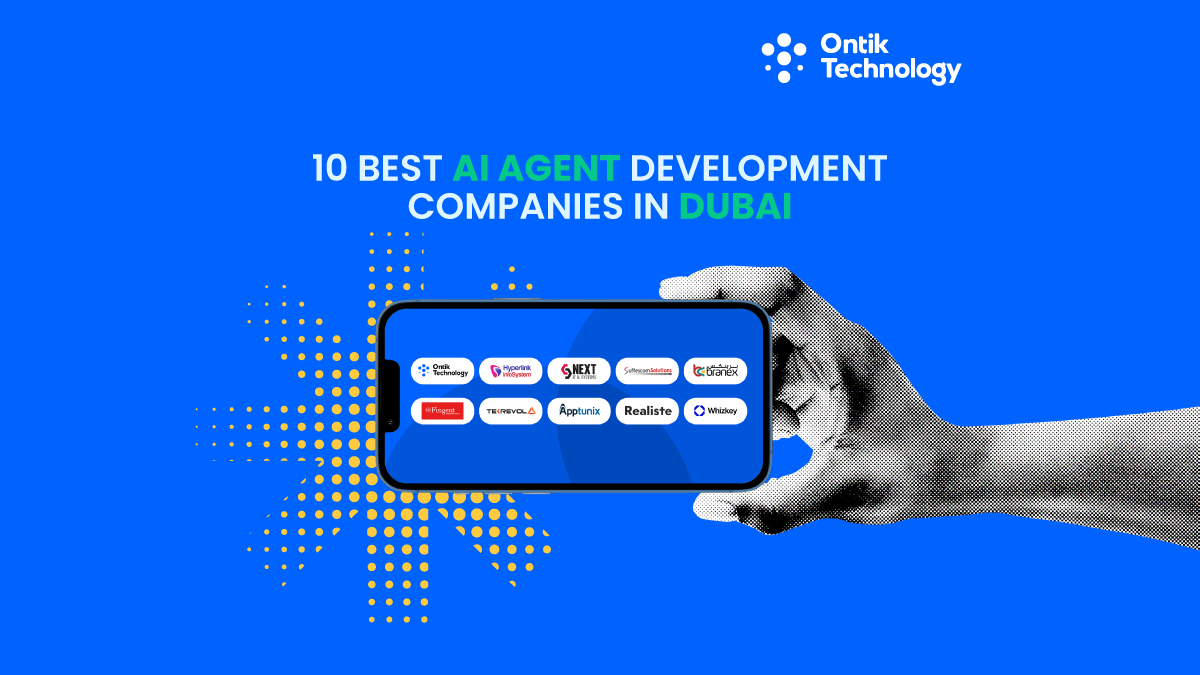

Key Takeaways
- Dubai is a global hub for agentic AI, backed by $100B+ investment, strong government support, and a fast-growing enterprise adoption ecosystem.
- Agentic AI goes beyond automation by enabling autonomous reasoning, planning, and decision-making without constant human input.
- Leading Dubai-based AI companies specialize in generative AI, multi-agent systems, machine learning, NLP, and computer vision across industries.
- Choosing the right AI partner requires focus on real delivery experience, regulatory knowledge, MLOps maturity, and business alignment.
- Successful AI adoption starts with focused MVPs, strong data pipelines, and scalable architecture, not over-engineered solutions.
Dubai commits over $100 billion to artificial intelligence, establishing itself as a global technology leader. More than 800 AI companies now operate across finance, retail, healthcare, and logistics, driving measurable transformation throughout the emirate.
Agentic AI marks a fundamental evolution beyond traditional automation. These systems reason independently, plan strategically, and adapt autonomously to changing conditions, making decisions without waiting for human instructions.
Real-world results validate this investment. Emirates NBD delivers 24/7 customer service through intelligent chatbots. DP World optimizes port operations using predictive analytics. Dubai Customs eliminated thousands of manual work hours with AI productivity engines.
Government initiatives accelerate adoption. The Dubai AI Roadmap 2031 and Smart Dubai provide strategic direction and funding. Free zones offer tax incentives and simplified regulations. This guide examines top agentic AI development companies in Dubai, evaluating technical expertise, delivery records, and capabilities across generative AI, machine learning, and computer vision services.
What is Agentic AI and AI Development Services?
Agentic AI refers to autonomous systems that think, plan, and act independently. These intelligent agents go far beyond simple automation. They understand context, evaluate multiple options, and execute complex tasks without constant human supervision.
Traditional AI follows predefined rules and patterns. You program it to respond to specific inputs with predetermined outputs. Agentic AI breaks free from these limitations. It assesses situations dynamically, considers various strategies, and chooses optimal actions based on its training and defined goals.
AI development services encompass the complete spectrum of building intelligent solutions for businesses. Machine learning services involve supervised, unsupervised, and reinforcement learning techniques. Natural language processing services enhance communication and content understanding across platforms. Computer vision services focus on image recognition, object detection, and visual analytics that transform how companies process visual data.
A practical example clarifies this distinction effectively. A traditional customer service bot answers frequently asked questions by matching queries to a static database. An agentic AI customer service agent understands nuanced customer intent, accesses multiple data sources simultaneously, resolves complex issues through reasoning, and escalates appropriately without any human intervention.
Key differences between traditional and agentic approaches:
- Traditional AI responds only to direct commands while agentic AI initiates actions independently
- Traditional systems follow rigid predetermined rules while agentic systems adapt strategies based on context
- Traditional AI requires constant human input while agentic AI operates autonomously for extended periods
- Traditional models handle single isolated tasks while agentic systems manage complex interconnected workflows
- Traditional AI cannot learn from unexpected situations while agentic systems improve through experience
Artificial intelligence companies in Dubai build both types of systems depending on business needs. However, the shift toward agentic models accelerates as organizations demand more sophisticated automation. AI development companies create predictive analytics services to help businesses make data-driven decisions faster. They deploy generative AI services including intelligent chatbots, automated content generation, and video creation solutions.
The software development company landscape in Dubai now prioritizes seamless integration of AI capabilities. Custom software development projects increasingly incorporate machine learning algorithms and intelligent automation features. This transformation touches every sector from banking apps with fraud detection to e commerce platforms with personalized recommendations.
The Rise of AI Development in Dubai
Dubai positions itself aggressively as a global AI innovation hub. The government launched the UAE AI Strategy with an ambitious goal to make the country a world leader in artificial intelligence by 2031. This comprehensive plan touches education, transportation, healthcare, government services, and economic development.
Smart Dubai initiatives demonstrate tangible commitment to this vision. The Ministry of Health and Prevention uses AI for diagnostic support and healthcare solutions. Dubai actively tests autonomous vehicle integration and intelligent traffic management systems. Government agencies integrate AI to enhance citizen services and streamline operations.
The tech industry in Dubai benefits from several structural advantages. The city offers strategic geographic positioning between Eastern and Western markets. It provides access to world class talent recruited from across the globe. Multiple free zones deliver substantial tax benefits and simplified business setup processes.
Major technology players recognize Dubai's potential. Microsoft has invested $10 billion in OpenAI, advancing AI capabilities worldwide. NVIDIA commands 87% of the GPU market, providing crucial hardware for AI technologies. Apple stands as the largest AI company by market capitalization as of 2024.
Key factors driving AI growth in Dubai:
- Over $100 billion committed to AI infrastructure and development initiatives
- More than 800 companies actively deploying AI solutions across various sectors
- Government-backed programs including Dubai 2030 vision and UAE Digital Government strategy
- Strategic free zones like Dubai Internet City, DIFC Innovation Hub, and Hub71
- Advanced telecommunications and cloud infrastructure supporting AI workloads
- Access to regional markets across Middle East, Africa, and South Asia
- Growing ecosystem of AI talent, researchers, and specialized developers
Local champions emerge alongside global giants. G42 operates as a national-scale AI and cloud computing company focusing on large-scale solutions. Saal.ai provides data-driven cognitive solutions specifically for defense, healthcare, and finance sectors. These firms prove that artificial intelligence expertise grows rapidly within the region itself.
Digital transformation accelerates across various industries throughout the UAE. Retail platforms like Noon and Amazon.ae deploy AI for personalized shopping experiences. Banking institutions employ intelligent systems for real-time fraud detection and sophisticated risk assessment. Logistics companies optimize delivery routes and predict demand patterns with remarkable accuracy.
How to Choose the Right Agentic AI Development Company in Dubai
Selecting the right AI development company requires systematic evaluation beyond marketing claims. You need a reliable partner who delivers intelligent solutions aligned with your business goals. The wrong choice leads to wasted resources and missed opportunities.
Start by verifying genuine local presence and deep regulatory knowledge. Companies operating in Dubai must understand UAE data protection laws and evolving compliance requirements. They should demonstrate proven familiarity with industry-specific regulations governing finance, healthcare, or government sectors.
Technical expertise matters significantly for project success. Request detailed case studies showing completed AI projects with measurable business outcomes. A strong artificial intelligence company showcases successful implementations across different industries. They provide transparent timelines and clearly explain their development methodology.
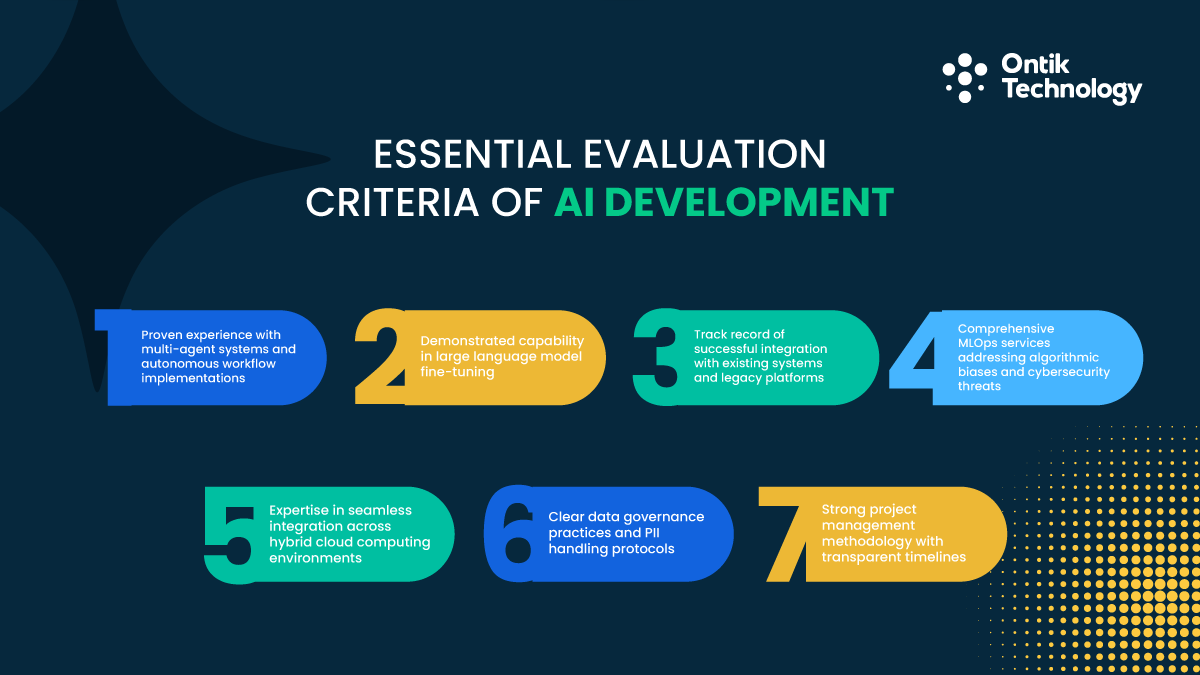
Essential evaluation criteria include:
- Proven experience with multi-agent systems and autonomous workflow implementations
- Demonstrated capability in large language model fine-tuning and deployment
- Track record of successful integration with existing systems and legacy platforms
- Comprehensive MLOps services addressing algorithmic biases and cybersecurity threats
- Expertise in seamless integration across hybrid cloud computing environments
- Clear data governance practices and PII handling protocols
- Strong project management methodology with transparent timelines
Evaluate their technology stack and strategic partnerships carefully. Leading companies work with cutting edge technology from OpenAI, Google, Microsoft, and other AI research leaders. They understand when to recommend proprietary models versus open-source alternatives. Their teams stay current with emerging technologies through continuous learning.
Assessment criteria should include proven project management capabilities. The best development company partners demonstrate clear communication patterns and collaborative problem solving skills. They involve you in critical decisions while independently handling technical complexities.
Critical red flags to watch for:
- Companies lacking documented case studies or published technical white papers
- Firms promising unrealistic timelines without proper discovery phases
- Vendors unable to explain their data governance and security practices
- Providers focusing exclusively on technology without understanding business strategy
- Companies with no references from clients in similar industries
Cost transparency proves essential for establishing trust. Reputable firms provide detailed breakdowns of project scope and comprehensive pricing structures. They explain specific cost drivers including data preparation, model training, cloud infrastructure, and ongoing maintenance. Hidden fees indicate potential problems down the road.
Top 10 Agentic AI Development Companies in Dubai, UAE
Dubai hosts numerous AI companies competing across sectors with varying capabilities. We evaluated firms based on agentic AI expertise, verified project delivery records, technical depth, and documented client success stories. The following companies represent the strongest options for building autonomous intelligent systems.
1. Ontik Technology

Ontik Technology leads in custom AI and machine learning development for enterprise clients worldwide. With 220+ successful projects across 20+ countries, they specialize in intelligent automation that addresses complex business challenges with measurable results—clients report 35% cost savings, 48% faster procurement cycles, and 58% increased engagement.
Core AI Capabilities: Their expertise spans generative AI implementation, advanced machine learning, and natural language processing. They build AI agents that integrate seamlessly into existing systems, delivering solutions through MVP development, dedicated teams, and custom software development.
Comprehensive Technology Services: Beyond AI, Ontik offers web development, mobile app development, blockchain solutions, UI/UX design, business intelligence, and cloud solutions.
Key Strengths:
- Transparent project management with clear milestone tracking
- Proven on-schedule delivery with 99.95% platform uptime achievements
- Comprehensive MLOps practices ensuring production reliability
- Strong presence in Dubai's software market and AI chatbot solutions
- Flexible staff augmentation services with full team setup in 2 weeks
Industries Served: Finance, healthcare, retail, real estate, and logistics benefit from their domain expertise and agile, collaborative approach.
Recognized by Stanford Seed Spark Program and as a Top 100 Finalist in Google Cloud's AI For Impact challenge, Ontik combines technical excellence with practical business acumen to deliver transformative solutions.
2. Hyperlink InfoSystem
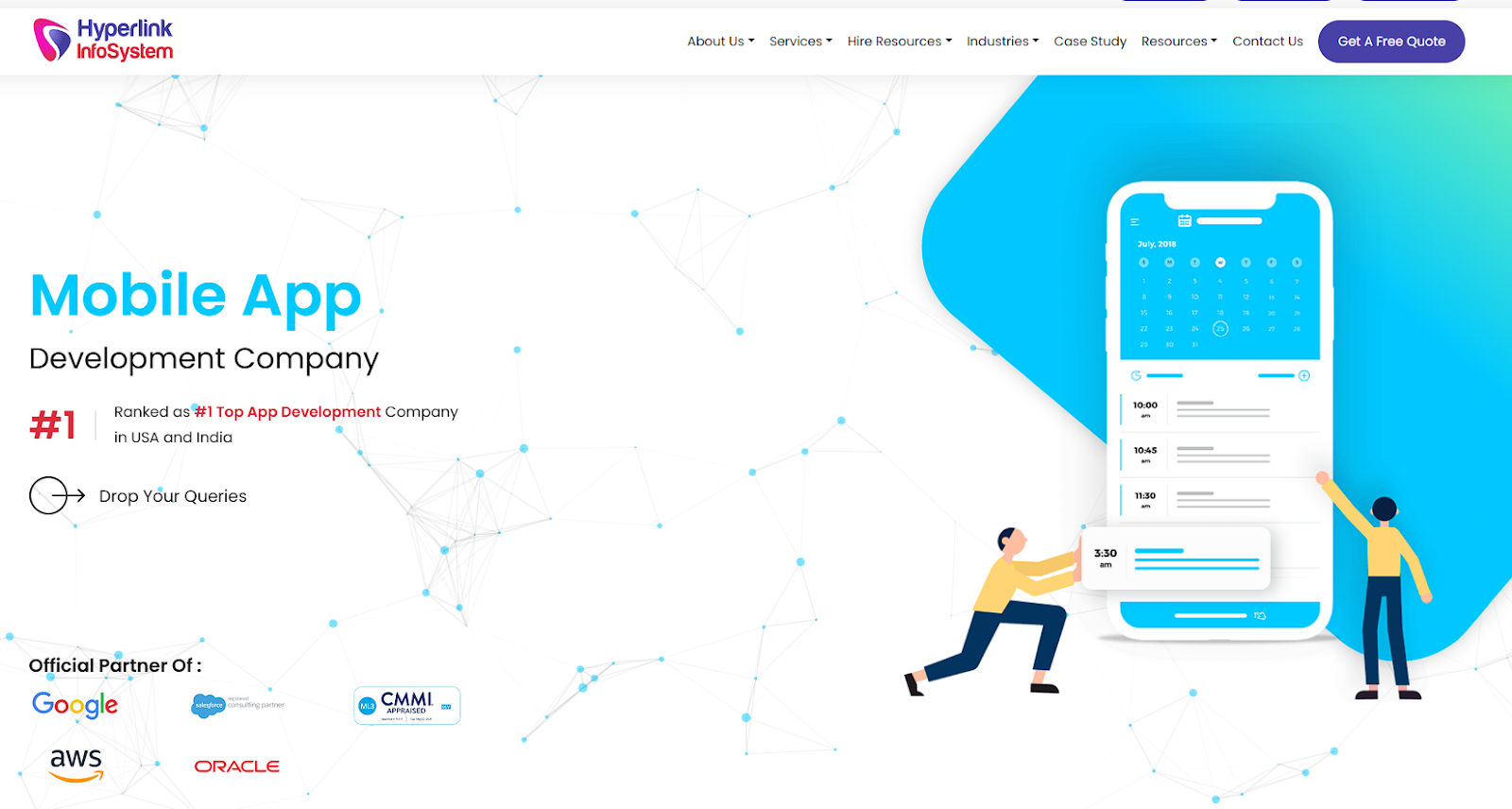
Hyperlink InfoSystem operates as a global software development company with substantial AI capabilities. They have completed over 1,500 transformative projects since their founding in 2009. Their Dubai presence serves clients across the Middle East region with localized support.
The firm specializes in AI powered mobile apps and comprehensive web development solutions. They build sophisticated predictive analytics platforms, intelligent voice assistants, and advanced computer vision applications. Their teams handle high-volume enterprise AI builds while maintaining consistent quality standards.
Notable features and services:
- Proven delivery speed with extensive portfolio demonstrating versatility
- Cost effective solutions without compromising on innovation or quality
- Experience across e commerce, banking, healthcare, and education sectors
- Dedicated teams organized by technology stacks and industry verticals
- Strong emphasis on user experience and practical functionality
3. Next UAE
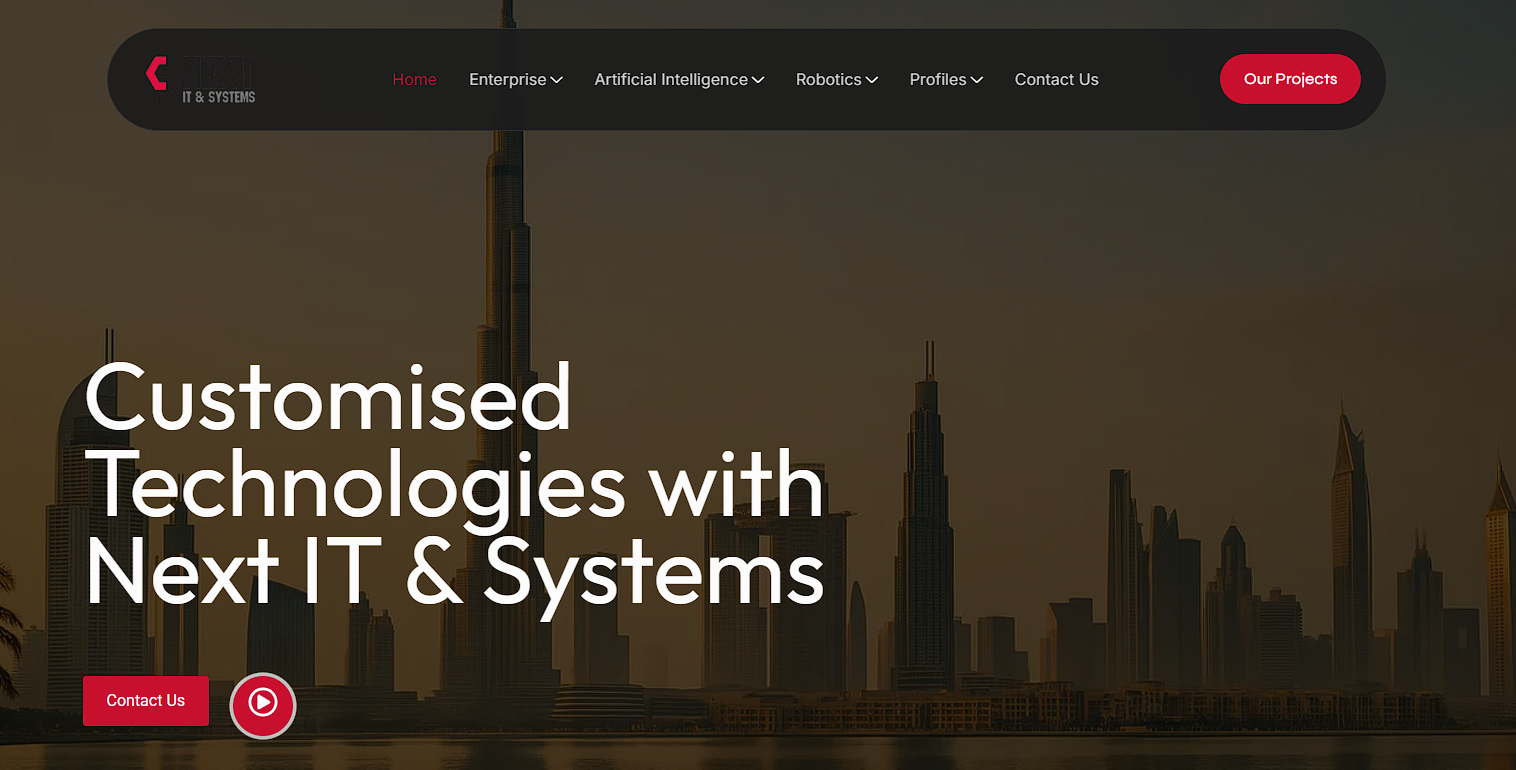
Next UAE positions itself as a comprehensive technology solutions provider with deep local roots. They offer custom software development, digital solutions, and strategic AI integration services. Their approach combines intimate local market knowledge with access to global technological solutions.
The company focuses on helping businesses navigate digital transformation through practical artificial intelligence applications. They build intelligent solutions that genuinely streamline operations and measurably improve customer engagement. Their services span from initial strategy development through complete implementation.
Core advantages include:
- Deep understanding of unique UAE market dynamics and business culture
- Effective navigation of local regulations and compliance requirements
- Consultative approach focusing on solving real problems over technology trends
- Pragmatic methodology resulting in higher user adoption rates
- Primary industries: government agencies, real estate, hospitality, retail
4. Suffescom Solutions
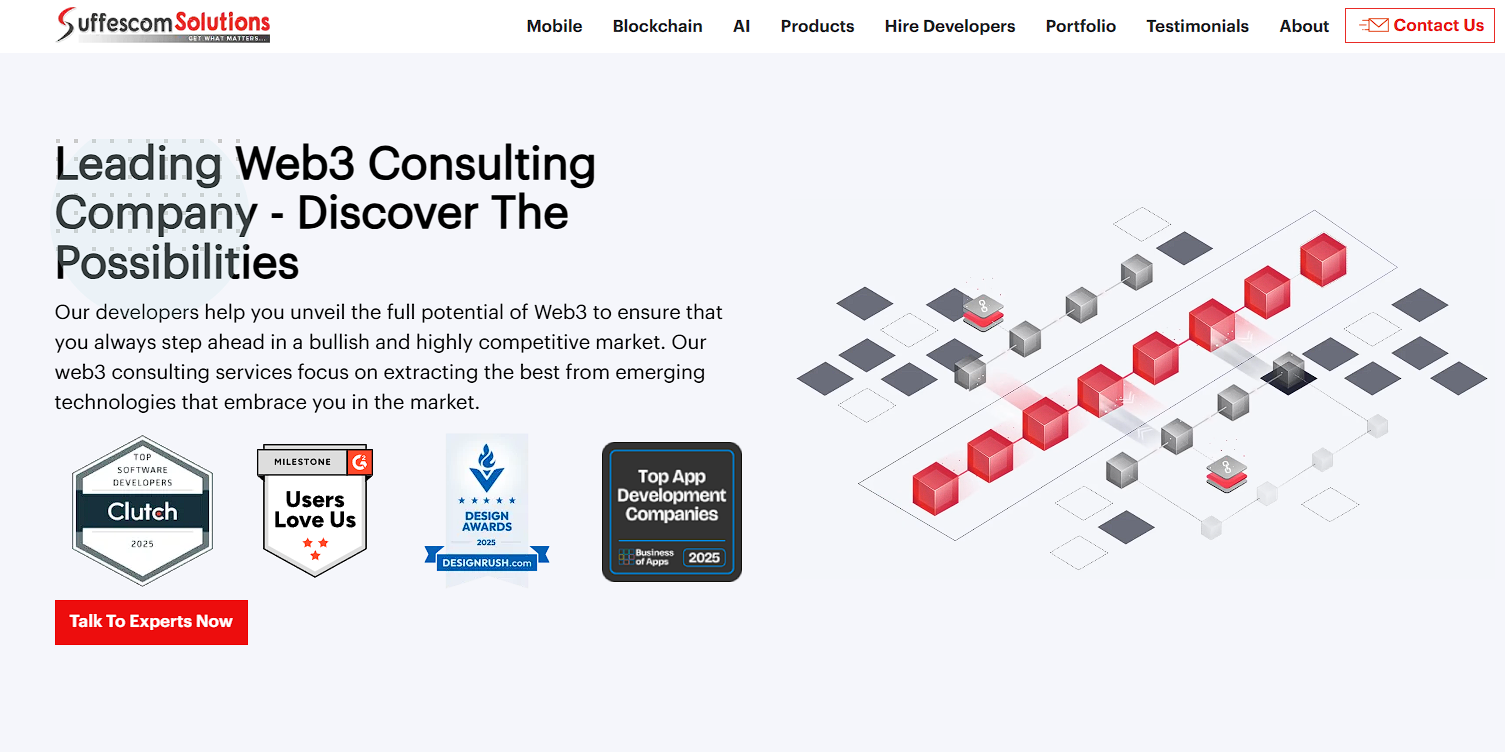
Suffescom Solutions operates across software development and multiple emerging technology domains. They build enterprise AI systems, blockchain solutions, and innovative metaverse applications. Their AI practice emphasizes automation tools and intelligent process optimization that reduces costs.
The company develops AI software for diverse industries with strong emphasis on scalability. They handle entire project lifecycles from initial concept through final deployment. Their technical teams actively stay current with AI research and evolving implementation best practices.
Key differentiators:
- Strong capabilities in complex system integration across platforms
- Successful combination of AI with complementary technologies like IoT and blockchain
- Experience with enterprise-level deployments reflected in robust architecture
- Comprehensive documentation and knowledge transfer programs
- Focus areas: supply chain management, manufacturing, finance, gaming
5. Branex

Branex operates as a full-service digital agency with specialized AI capabilities and creative strength. They combine creative design excellence with solid technical development to deliver engaging digital experiences. Their AI practice focuses on enhancing user interactions and intelligently personalizing content.
The firm builds AI driven solutions for both web and mobile platforms with emphasis on user experience. They integrate natural language processing for improved communication between systems and users. Their teams create intelligent dashboards that transform complex data into actionable insights.
What sets them apart:
- Excellence at making sophisticated AI accessible and genuinely user-friendly
- Design-first approach resulting in intuitive interfaces for complex systems
- Ability to explain technical concepts clearly in business terms
- Strong creative applications of AI technology beyond standard implementations
- Specialized in marketing agencies, media companies, corporate websites, consumer apps
6. Fingent
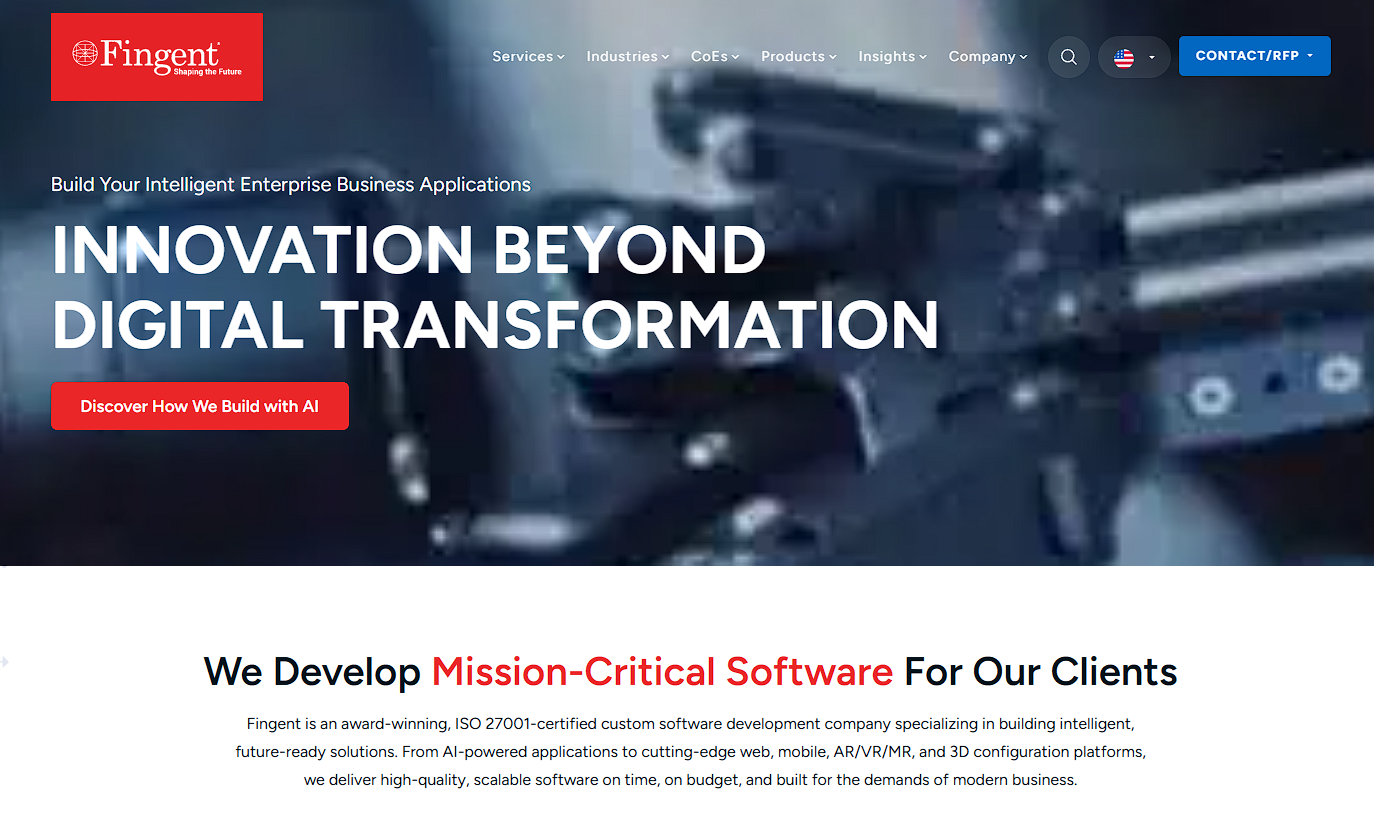
Fingent brings over two decades of custom software development experience to the AI space. They have evolved into a leading AI development company serving enterprise clients across global markets. Their Dubai operations focus specifically on AI implementation tailored for Middle East business requirements.
The company specializes in strategic AI integration that solves clearly defined business challenges. They build accurate predictive models, automate complex workflows, and enhance decision-making systems. Their consulting services help organizations develop comprehensive AI strategies aligned with business objectives.
Primary strengths:
- Deep industry knowledge across heavily regulated sectors
- Understanding of complex compliance requirements and data governance needs
- Enterprise focus enabling effective handling of complex stakeholder requirements
- Strong technical documentation supporting long-term system maintenance
- Key industries: healthcare, financial services, manufacturing, transportation
7. Tekrevol
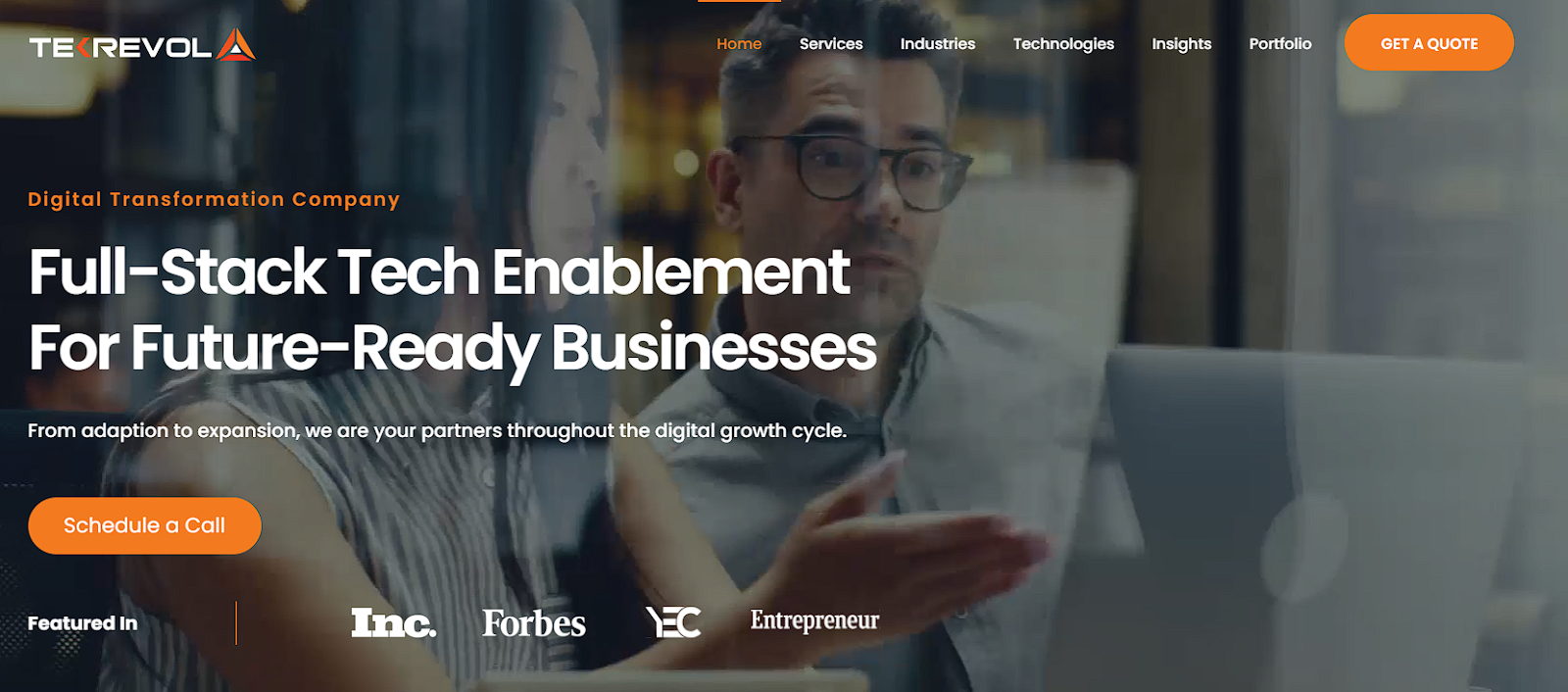
Tekrevol operates as a mobile-first development company with impressive AI capabilities. They build app development solutions that strategically leverage machine learning and intelligent automation. Their dedicated focus on mobile platforms differentiates them in the competitive market.
The company creates sophisticated AI powered features specifically optimized for consumer and enterprise mobile apps. They implement smart recommendation engines, predictive analytics, and natural language interfaces. Their teams optimize ruthlessly for performance on mobile devices and varying network conditions.
Distinguishing features:
- Excellence at creating engaging mobile experiences powered by AI
- Deep understanding of mobile user behavior patterns and expectations
- Rapid development cycles suitable for startups testing new concepts
- Strong client reviews highlighting creativity plus reliable execution
- Expertise across iOS, Android, and cross-platform development frameworks
8. Apptunix

Apptunix positions itself as an innovation-focused development company embracing emerging technologies. They build digital products that incorporate the latest AI and machine learning capabilities. Their comprehensive services span mobile apps, web platforms, and enterprise software solutions.
The firm develops intelligent solutions for businesses actively seeking competitive advantages through technology. They create AI systems that continuously learn from user behavior and optimize automatically. Their approach emphasizes measurable business outcomes over innovation for its own sake.
Notable characteristics:
- Strong combination of technical skills with business understanding
- Projects framed around specific goals like cost reduction or satisfaction improvement
- Iterative development approach allowing adjustments based on early results
- Dedicated teams matched to appropriate expertise for each project
- Primary sectors: retail, healthcare, logistics, education, entertainment
9. Realiste AI

Realiste AI specializes exclusively in artificial intelligence and machine learning solutions. They focus on building production-ready AI systems designed for demanding enterprise environments. Their boutique approach enables deep customization and exceptional attention to technical details.
The company develops sophisticated AI agents, automated workflows, and intelligent decision support systems. They excel particularly at natural language processing and computer vision applications requiring advanced capabilities. Their team includes AI researchers who actively contribute to advancing the field.
Core competencies:
- Deep technical expertise in cutting edge AI methods and research
- Ability to handle complex challenges requiring advanced techniques
- Research background ensuring they remain at forefront of AI innovation
- Collaborative approach creating sustainable long-term implementations
- Specialized focus: financial services, legal technology, healthcare, research institutions
10. Whizkey

Whizkey operates as a comprehensive technology partner for businesses navigating digital transformation. They provide AI development services alongside broader IT solutions and infrastructure support. Their integrated approach addresses infrastructure, applications, and intelligent automation together cohesively.
The company builds AI systems that measurably enhance operational efficiency across various business functions. They automate repetitive tasks, provide predictive insights, and improve decision-making processes. Their services include strategy consulting, hands-on implementation, and ongoing support.
Value propositions:
- Understanding of challenges facing mid-market companies adopting AI
- Accessible entry points without overwhelming clients with complexity
- Bundled services simplifying vendor management and accountability
- Patient approach to change management and user training
- Target markets: SMEs, government agencies, professional services, manufacturing
Emerging Agentic AI Trends in Dubai and UAE for 2025
The AI landscape evolves rapidly as generative AI moves decisively from experimentation to production deployment. Dubai businesses now implement multi-agent systems where multiple AI models coordinate seamlessly. These orchestrated solutions handle complex workflows that previously required extensive human intervention.
Autonomous workflow automation represents a transformative trend across sectors. Companies deploy AI agents that manage complete end-to-end business processes independently. These systems continuously monitor performance, proactively identify bottlenecks, and adjust operations automatically.
Enterprise AI adoption accelerates particularly across regulated industries with strict compliance requirements. Financial institutions deploy sophisticated AI for fraud detection, nuanced risk assessment, and personalized customer service. Healthcare organizations leverage AI for diagnostic support and patient care optimization.
Major trends shaping 2025 include:
- Multi-agent orchestration enabling systems where multiple AI agents collaborate on complex problems
- Agentic RPA combining robotic process automation with reasoning and adaptive capabilities
- Private LLMs allowing organizations to deploy proprietary language models for enhanced data security
- AI-powered analytics delivering real-time insights that drive immediate business decisions
- Sector-specific solutions tailored precisely for finance, real estate, logistics, and healthcare
- AI copilots working alongside employees to enhance productivity across functions
- Autonomous decision systems making operational choices without human approval
AI copilots emerge as powerful productivity enhancers throughout organizations. These intelligent assistants work directly alongside employees, efficiently handling routine tasks and providing contextual recommendations. They access multiple data sources simultaneously and draft initial responses. Human workers focus their energy on strategic decisions while AI handles operational details.
Dubai's government continues aggressively driving adoption through the comprehensive UAE AI Strategy. The Smart Dubai initiative expands AI integration systematically across city services. This creates a valuable testing ground for innovative applications that later scale regionally and globally.
Natural resources sectors actively explore promising AI applications beyond traditional tech industries. Energy companies deploy predictive maintenance systems to reduce costly downtime. Environmental monitoring programs employ computer vision for precise tracking and analysis.
The tech companies in Dubai ecosystem matures with increased collaboration between stakeholders. Startups partner strategically with established firms to bring innovations to market faster. Universities and research institutions contribute meaningfully to AI research addressing specific regional challenges.
Comparing Top AI Companies: Capabilities and Specializations
Choosing among top AI companies requires understanding their unique strengths and specializations. Each firm brings different capabilities, industry focus, and service approaches to projects. This comparison helps you match company expertise precisely with your specific needs.
| Company | Core Strength | Best For | Starting Price Range |
|---|---|---|---|
| Ontik Technology | Custom enterprise AI | Complex business automation, MVP Development, AI, SaaS, Software Development | AED 200K – 650K |
| Hyperlink InfoSystem | High-volume delivery | Mobile AI applications | AED 120K – 400K |
| Next UAE | Local market expertise | Government and real estate | AED 150K – 500K |
| Suffescom Solutions | System integration | Multi-technology projects | AED 180K – 550K |
| Branex | Design-led AI | Consumer-facing applications | AED 100K – 350K |
| Fingent | Enterprise consulting | Regulated industries | AED 250K – 800K |
| Tekrevol | Mobile-first approach | Consumer apps and startups | AED 80K – 300K |
| Apptunix | Business outcomes focus | ROI-driven implementations | AED 150K – 500K |
| Realiste AI | Advanced ML | Research and specialized AI | AED 300K+ |
| Whizkey | SME accessibility | Mid-market companies | AED 70K – 250K |
Project delivery timelines vary significantly by company capabilities and project scope. Simple AI implementations typically require 8 to 12 weeks from kickoff to deployment. Complex enterprise systems demand 20 to 28 weeks for complete implementation. Most companies offer phased approaches that deliver incremental value.
Technical capabilities differ substantially across providers. Some firms excel specifically at natural language processing for conversational interfaces. Others specialize in computer vision for visual analytics and recognition tasks. Still others focus on predictive analytics for forecasting and optimization.
Key differentiation factors include:
- Industry experience with some companies focused on finance while others serve retail or healthcare
- Company size impacting service delivery with larger firms offering comprehensive services
- Geographic presence affecting collaboration quality and understanding of local business culture
- Technology partnerships determining access to cutting edge tools and preferential pricing
- Support models ranging from basic maintenance to comprehensive optimization programs
Company size significantly impacts service delivery models. Larger software development firms offer comprehensive services spanning strategy through maintenance. Boutique AI companies provide highly personalized attention and customization. Match company scale appropriately to your project requirements and ongoing support needs.
AI Development Cost in Dubai
Understanding AI development costs helps you budget appropriately and evaluate vendor proposals effectively. Prices vary considerably based on project scope, technical complexity, and company expertise. Dubai rates reflect the city's position as a premium technology market with access to global talent.
Discovery and strategy phase typically costs AED 30,000 to 90,000. This covers business analysis, technical feasibility assessment, and roadmap development. Smart companies invest here to reduce implementation risks significantly.
Proof of concept projects running 4 to 8 weeks range from AED 70,000 to 250,000. You validate core assumptions and test critical functionality. This phase proves technical viability before full investment commitment.
MVP development taking 8 to 16 weeks costs AED 200,000 to 650,000. You build a working system with essential features. Early user feedback guides further development priorities effectively.
Enterprise rollout requiring 16 to 28 weeks ranges from AED 600,000 to 1,800,000 or more. Full-scale implementation includes integration, testing, training, and deployment across the organization.
Ongoing MLOps and maintenance runs AED 25,000 to 120,000 monthly. This covers monitoring, retraining, optimization, and support to keep systems performing well.
Major cost drivers in AI projects:
- Data preparation including cleaning, labeling, and organizing datasets consuming 40 to 60 percent of budgets
- Model complexity with sophisticated multi-agent systems costing more than simple classification
- Infrastructure expenses covering cloud computing, storage, and API usage
- Token pricing for services like OpenAI adding ongoing operational costs
- Integration complexity when connecting to existing systems and legacy platforms
- Compliance requirements adding security measures and audit capabilities
- Team expertise with senior AI architects commanding premium rates
- Testing and validation ensuring accuracy, fairness, and reliability
Ongoing infrastructure costs include cloud, storage, and API expenses, alongside token pricing for services like OpenAI and data volume/query frequency charges for vector databases (e.g., Pinecone, Weaviate).
Integrating AI into existing, often legacy, systems significantly raises budgets, requiring custom connectors and increasing complexity across multiple platforms. Compliance requirements also add considerable costs in regulated sectors, such as specific data handling for PDPL, enhanced security/audit trails for banking, and stringent medical data protection for healthcare.
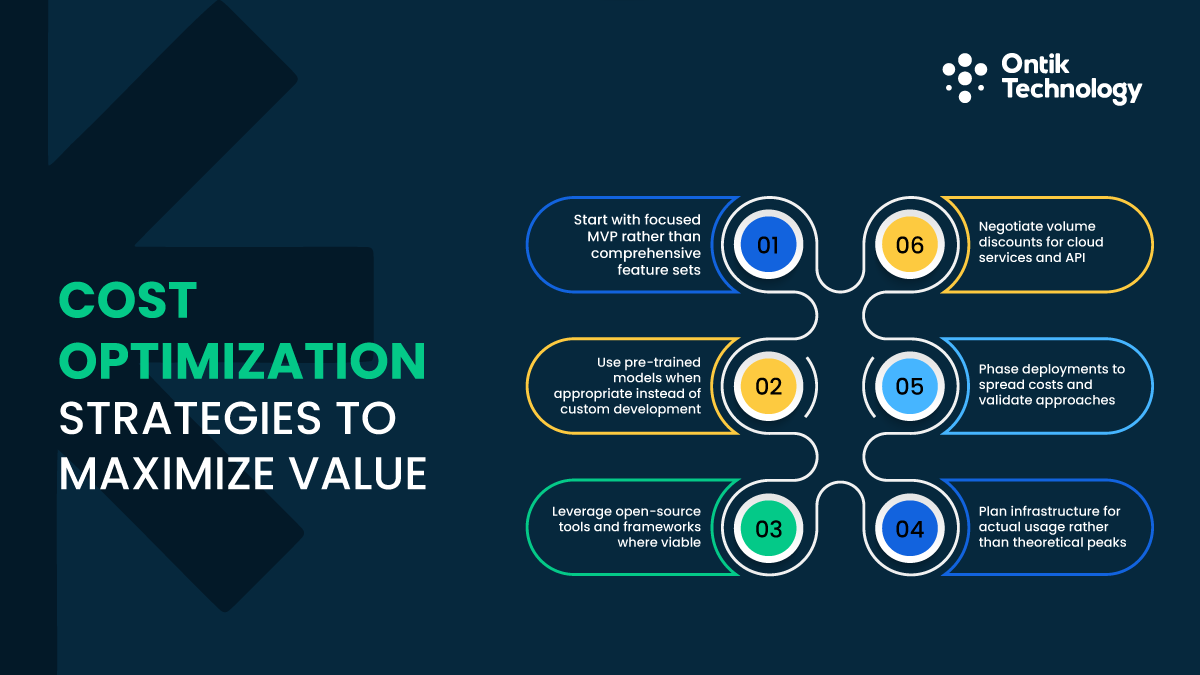
Cost optimization strategies to maximize value:
- Start with focused MVP rather than comprehensive feature sets
- Use pre-trained models when appropriate instead of custom development
- Leverage open-source tools and frameworks where viable
- Plan infrastructure for actual usage rather than theoretical peaks
- Phase deployments to spread costs and validate approaches
- Negotiate volume discounts for cloud services and API usage
Hidden costs frequently surprise organizations without AI experience. Change management and training require substantial investment beyond pure technology. User adoption programs ensure people actually use new AI systems effectively. Ongoing optimization maintains performance as business conditions evolve.
Tech Stack Used by Top AI Development Companies in Dubai
Artificial intelligence companies in Dubai employ sophisticated technology stacks to build robust, scalable AI solutions. Understanding these tools helps you evaluate vendor capabilities realistically and make informed decisions about your AI projects.
Foundation models like OpenAI's GPT, Meta's Llama (open-source), and Google's multimodal Gemini power most AI applications. Frameworks simplify development: LangChain manages prompts and chains AI operations, Microsoft's AutoGen builds multi-agent systems, and CrewAI orchestrates teams of AI agents for shared goals.
Programming languages and runtime environments provide the foundation for implementation. Python dominates AI development due to its extensive libraries and active community support. Node.js serves well for building APIs and integrating AI into web applications. TypeScript adds valuable type safety for larger codebases.
Core technology components include:
- Foundation models: OpenAI GPT, Meta Llama, Google Gemini for language understanding
- AI frameworks: LangChain for LLM applications, AutoGen for multi-agent systems, CrewAI for orchestration
- Programming languages: Python for AI development, Node.js for APIs, TypeScript for type safety
- Vector databases: Pinecone for managed search, Weaviate for hybrid capabilities, ChromaDB for open-source
- Cloud platforms: AWS UAE region, Microsoft Azure, Google Cloud Platform for infrastructure
- Development tools: Docker and Kubernetes for deployment, GitHub Actions for automation
Vector databases store and retrieve embeddings efficiently for semantic search. Pinecone provides managed vector search at impressive scale. Weaviate combines vector search capabilities with traditional database features. ChromaDB offers open-source options for organizations preferring self-hosted solutions.
AWS is strong in the UAE with local data centers for data residency. Azure suits enterprises using Microsoft ecosystems. Google Cloud Platform offers unified AI and infrastructure. Data processing uses Apache Spark for distributed large datasets, Apache Kafka for high-throughput real-time streams, and dbt for transforming raw data into analytics-ready formats.
Development and deployment infrastructure includes:
- Containerization using Docker for consistent environments and Kubernetes for orchestration
- Automated pipelines with GitHub Actions or GitLab for testing and deployment
- Experiment tracking through MLflow or Weights & Biases for model development
- Monitoring systems using Prometheus and Grafana for observability
- Workflow orchestration via Apache Airflow for complex data pipelines
- Security management with HashiCorp Vault for secrets and encryption keys
Security and governance tools protect sensitive information and ensure compliance. HashiCorp Vault manages secrets and encryption keys securely. Apache Ranger provides fine-grained access control across data sources. Data lineage tools track how information flows through systems.
Testing frameworks verify AI system behavior across multiple dimensions. Pytest handles traditional software testing for code quality. Specialized tools evaluate model accuracy, fairness, and robustness comprehensively. Red-teaming techniques identify potential vulnerabilities and failure modes.
Final Thoughts
Dubai's AI ecosystem thrives with over 800 companies deploying intelligent solutions, backed by strong government support and advanced infrastructure. The shift toward agentic AI marks a fundamental transformation—these autonomous systems handle complex workflows independently, adapting to changing conditions without constant human intervention.
Selecting the right development partner demands scrutiny beyond marketing claims. Examine verified delivery records, technical expertise, and proven compliance knowledge. Remember that costs extend far beyond initial development—data preparation, ongoing optimization, and infrastructure require substantial investment.
Success hinges on five critical factors: robust data governance, appropriate model selection, comprehensive monitoring systems, clear business objectives, and organizational readiness for change. Industries from financial services to healthcare already demonstrate measurable benefits through fraud detection, personalized experiences, and predictive maintenance.
Smart organizations start focused, solving specific problems before scaling systematically. Strong data pipelines, rigorous testing, and proper MLOps practices ensure long-term performance. Connect with Dubai's leading AI chatbot solutions providers to transform potential into proven business value.
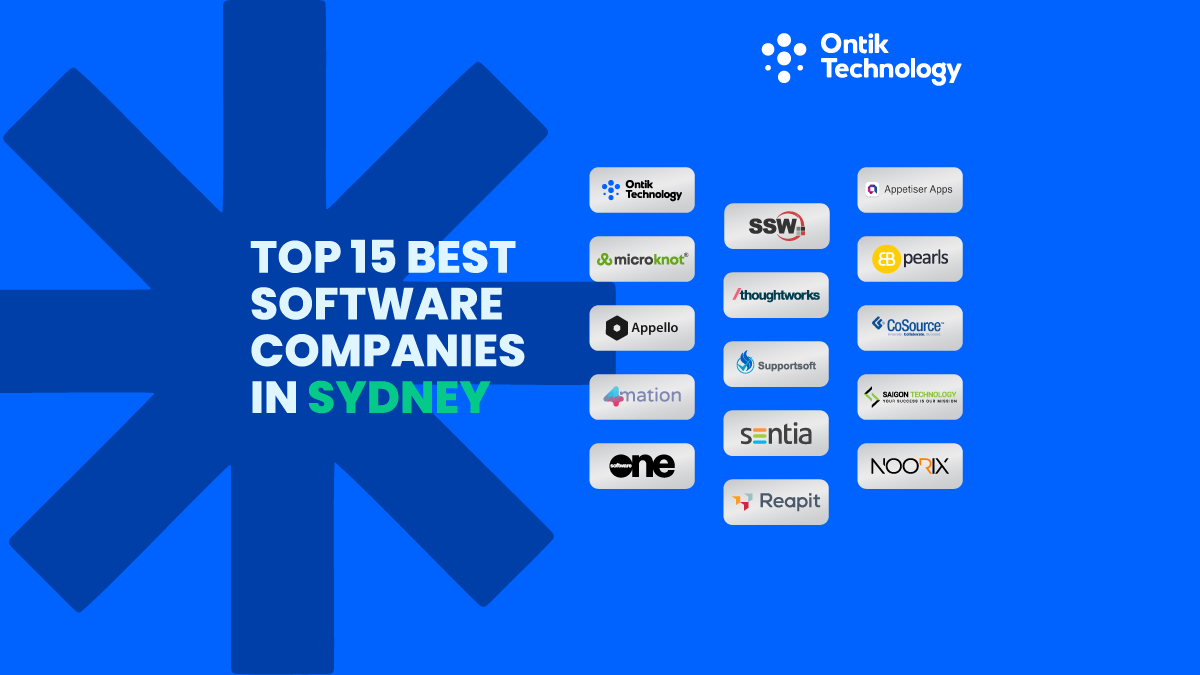

Key Takeaways
- Sydney is a leading Australian tech hub, with a fast-growing software market and deep talent pool across web, mobile, AI and enterprise solutions.
- The guide compares 15 top software development companies in Sydney, covering ratings, pricing, tech stacks, industries, and team sizes.
- Ontik Technology and several other firms offer strong AI, mobile, and custom software capabilities at competitive, startup-friendly rates.
- A clear checklist—experience, services, tech stack, portfolio, approach, pricing, and support- helps shortlist the right development partner.
- Typical Sydney projects range from AUD 10K to 100K+, with costs driven by scope, complexity, platform choice, tech stack, and post-launch support needs.
Sydney has rapidly become one of the fastest-growing tech hubs in the Southern Hemisphere. From AI-powered platforms to mobile apps, software development companies in Sydney are driving digital innovation across industries.
Australia's software development market reached USD 3.25 billion in 2024 and is projected to hit $17.15 billion by 2033. Sydney leads as the preferred base for top IT companies in Sydney. But choosing the right partner is challenging.
Not every software developer matches your vision, timeline, or budget. Some excel at custom software development, others at mobile app development or AI solutions. We have researched, compared portfolios, and analyzed reviews. This guide reveals the top 15 software development companies in Sydney redefining digital excellence in 2025. Let us find your perfect tech partner.
List of Top 15 Best Software Development Companies in Sydney
Below is a curated list of the best software development companies in Sydney, Australia. These firms have been evaluated based on ratings, expertise, case studies, plus client feedback. Each software development agency brings unique strengths to the table, from AI integration to blockchain development to mobile app development.
Here is a quick comparison to help you decide:
| Company Name | Clutch Rating | Min. Project Size | Hourly Rate | Team Size | Key Specialties |
|---|---|---|---|---|---|
| Ontik Technology | 4.8★ (31 reviews) | $10,000+ | < $25/hr | 150+ | AI, Mobile Apps, Blockchain |
| Simform | 4.8★ (81 reviews) | $25,000+ | $25–$49/hr | 1,000–9,999 | Custom Software, AI, CRM |
| TechnoYuga Soft | 5.0★ (64 reviews) | $10,000+ | < $25/hr | 50–249 | Custom Software, Mobile Apps |
| Innowise | 4.9★ (72 reviews) | $10,000+ | $50–$99/hr | 1,000–9,999 | Healthcare, Finance, AR/VR |
| EB Pearls | 5.0★ (59 reviews) | $5,000+ | $25–$49/hr | 250–999 | Full-Stack, Mobile Apps, AI |
| Appinventiv | 4.6★ (89 reviews) | $50,000+ | $25–$49/hr | 1,000–9,999 | AI, Mobile Development |
| Arcanys | 5.0★ (25 reviews) | $100,000+ | $25–$49/hr | 250–999 | Custom Software, Full-Stack |
| VT Digital | 5.0★ (25 reviews) | $1,000+ | $50–$99/hr | 10–49 | AI Solutions, Compliance |
| Hiteshi | 5.0★ (27 reviews) | $5,000+ | < $25/hr | 50–249 | Bespoke Software, AI |
| Appello Software | 4.9★ (33 reviews) | $50,000+ | $100–$149/hr | 50–249 | Healthcare, Fintech Apps |
| StepInsight | 4.9★ (11 reviews) | $25,000+ | $50–$99/hr | 10–49 | End-to-End Solutions |
| Tech Exactly | 4.9★ (25 reviews) | $5,000+ | < $25/hr | 50–249 | Mobile Apps, AI Consulting |
| Offshorly | 4.9★ (21 reviews) | $5,000+ | < $25/hr | 50–249 | Bespoke Software |
| Sentia | 4.8★ (6 reviews) | $25,000+ | $150–$199/hr | 10–49 | Scalable Web/Mobile |
| Quickworks | 5.0★ (2 reviews) | Varies | Competitive | 250–500 | White-Label SaaS, On-Demand |
Now let us explore each software company in detail.
1. Ontik Technology

Ontik Technology is a forward-thinking software consulting and development company that prioritizes innovation, research, plus employee growth. Founded in 2016, the company has grown to a team of 50 to 249 highly skilled software developers. They specialize in a wide range of cutting-edge technologies, including web development, mobile app development, cloud computing, artificial intelligence, machine learning, blockchain, plus more.
Core Services
Ontik Technology offers a comprehensive suite of custom software development services designed to meet diverse business needs:
- AI Development (30%): Building intelligent chatbots, image analyzers, and personalized recommendation engines
- IT Staff Augmentation (20%): Providing skilled software developers to support your in-house teams
- Mobile App Development (20%): Creating scalable and secure mobile apps for iOS and Android app development
- Custom Software Development (10%): Tailoring solutions to meet specific business needs
- Web Development (10%): Delivering robust web platforms and SaaS products
- E-Commerce Development (5%): Building online stores with seamless payment integrations
- Low/No Code Development (5%): Rapid prototyping using modern no-code platforms
Why Ontik Technology Stands Out
Ontik Technology specializes in building scalable and secure mobile apps plus web platforms, including SaaS products and AI-powered solutions. As a leading provider in the software development agency space, they focus on delivering tailored solutions that align with client objectives. Their cost rating of 4.8 out of 5 reflects their commitment to delivering exceptional value.
With a minimum project size of $10,000 and hourly rates under $25, Ontik offers competitive pricing without compromising quality. Their team focuses on innovation plus research, ensuring that every solution is future-ready.
Notable Strengths:
- Deep expertise in AI and machine learning integration
- Affordable pricing models suitable for startups and SMEs
- Strong focus on employee growth translates to better project outcomes
- Expertise in blockchain and Web3 technologies
Ontik Technology serves clients globally, making them an ideal partner for businesses in Sydney, Australia looking for cost-effective yet high-quality custom software development.
2. Simform
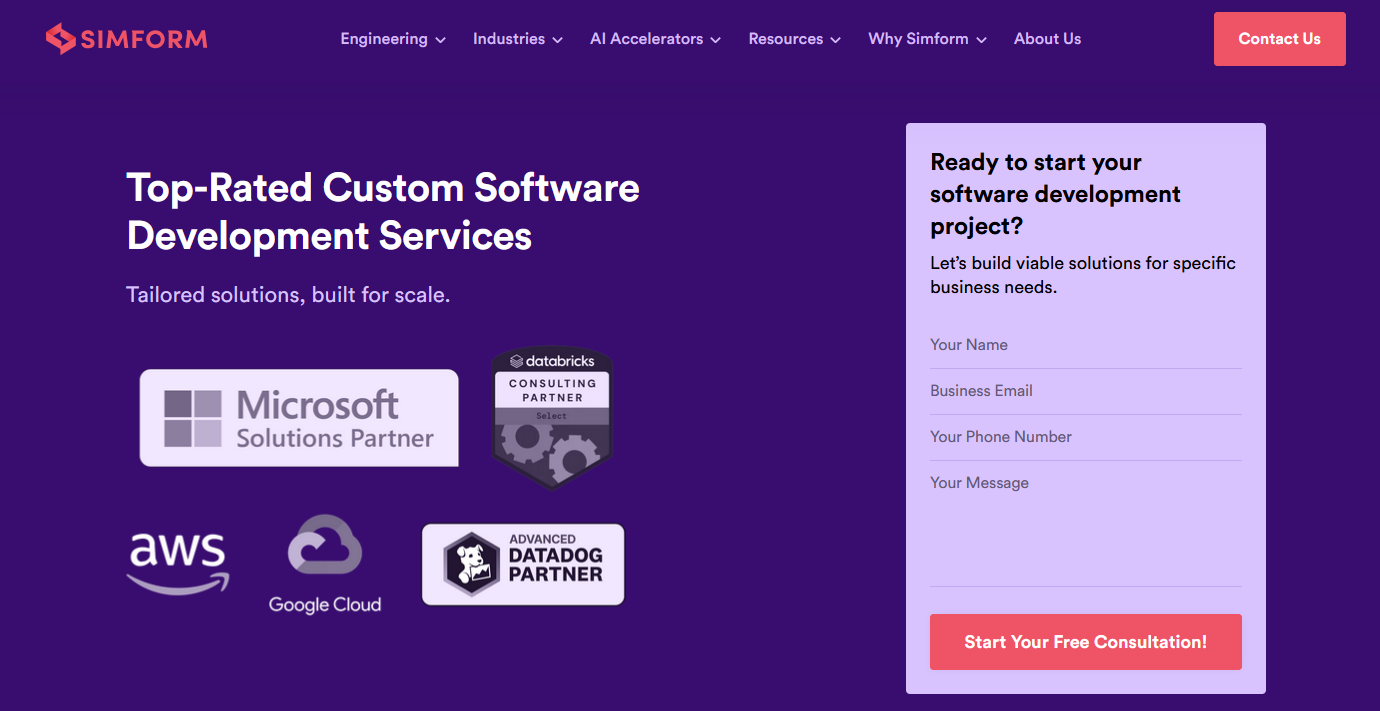
Simform delivers full-stack, end-to-end, and customized software development solutions. Rated 4.8 stars on Clutch (81 reviews), they are highly praised for technical expertise and communication, delivering innovative solutions across various industries.
Core Services
Simform provides a broad spectrum of custom software development services:
- Custom Software Development (10%)
- AI Development (10%)
- CRM Consulting and Systems Integration (plus 7 additional services)
- Cloud-based application development
- Quality assurance and testing services
- Business intelligence and data analytics solutions
Key Highlights
- Strong emphasis on effective communication
- Proven track record with global enterprises
- Agile methodologies enhance collaboration and rapidly achieve solutions
- Transparent project lifecycle management
- Focus on delivering tailored solutions that drive business outcomes
Simform serves Sydney software development clients and offers flexible engagement models, from fixed-price projects to dedicated development teams. Their commitment to continuous improvement keeps them at the industry forefront.
3. TechnoYuga Soft Pvt. Ltd.
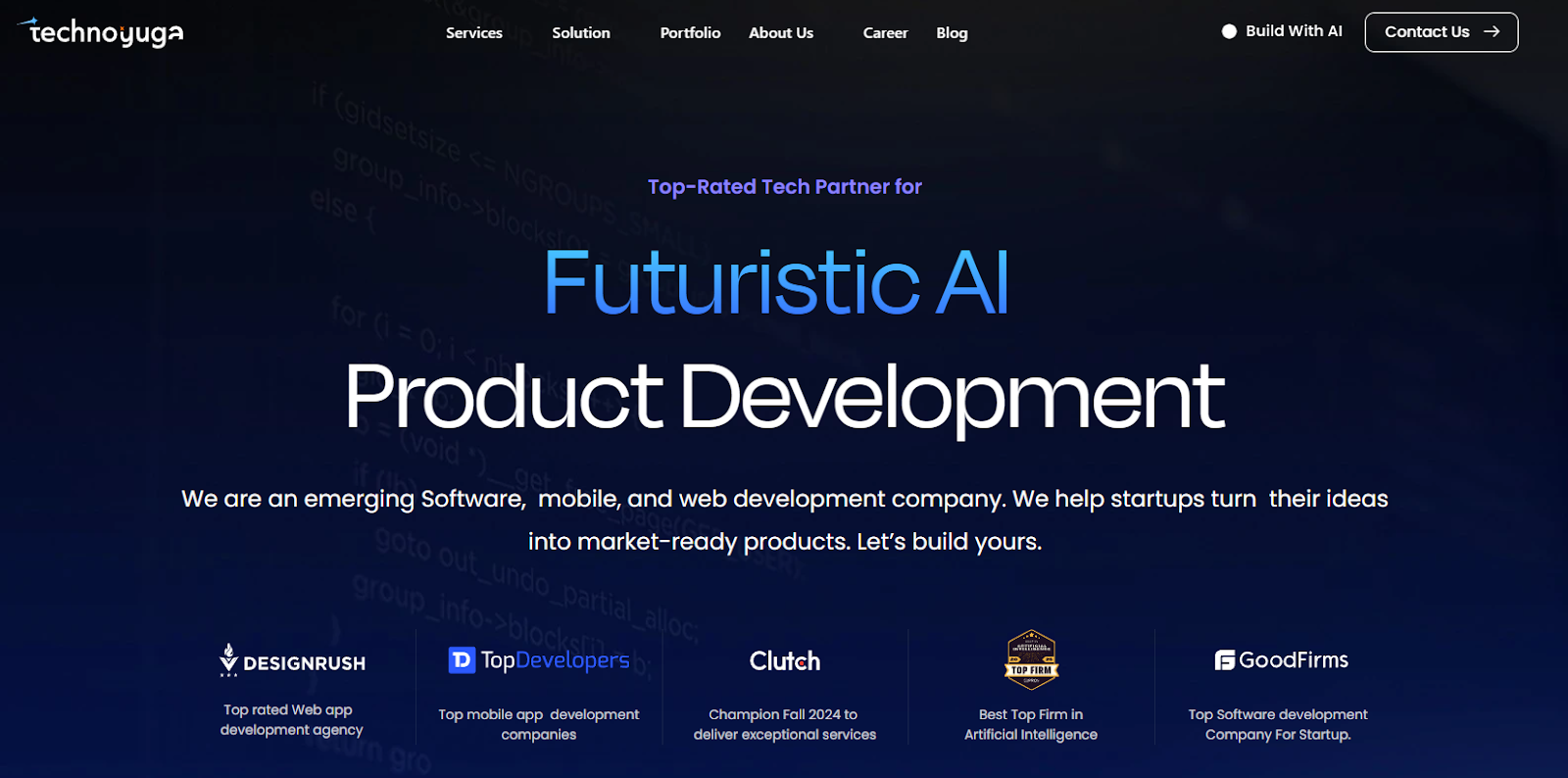
TechnoYuga Soft Pvt. Ltd. is a full-stack development firm offering comprehensive, custom software solutions for a wide range of industries. With a perfect 5.0-star rating based on 64 reviews, TechnoYuga consistently receives positive feedback.
Core Services
TechnoYuga focuses on three main areas:
- Custom Software Development (35%)
- Mobile App Development (35%)
- AI Development (20%)
- Plus one additional service line
Key Highlights
- Exceptional project management and timely delivery
- Scalable and user-friendly applications
- Proactive communication and strategic partnership approach
- User-centric design principles
- Excellence in developing software that addresses specific market needs
TechnoYuga's team of 50 to 249 software developers ensures personalized attention to every project. Their hourly rate of less than $25 makes them one of the most cost-effective options for custom software development in Sydney.
4. Innowise
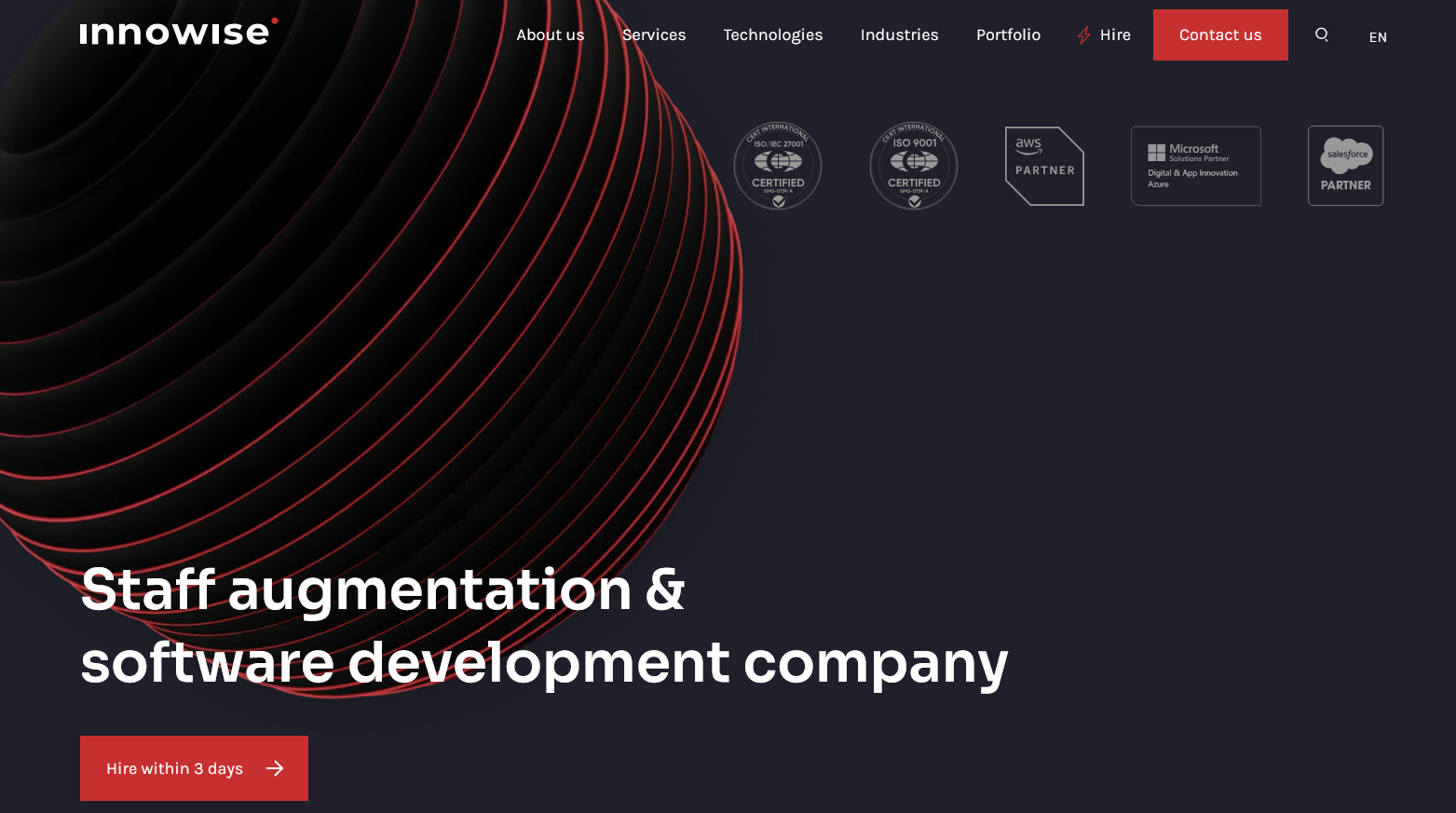
Innowise is a bespoke software development agency that provides end-to-end services, specializing in various sectors, including healthcare and finance. With a Clutch rating of 4.9 stars based on 72 reviews, Innowise boasts a 100% satisfaction rate. This leading provider excels at delivering innovative software solutions for complex enterprise requirements.
Core Services
Innowise offers a diverse range of software development services:
- Custom Software Development (10%)
- AI Development (10%)
- AR/VR Development (10%)
- Plus 7 additional services including cloud solutions and IoT
- Data analytics and business intelligence services
Key Highlights
- Exceptional responsiveness plus technical expertise
- Deliver on time and within budget
- Proven experience in regulated industries like healthcare and fintech
- Strong project management with Agile and Scrum methodologies
- Skilled at delivering tailored solutions for enterprise clients
Innowise serves Sydney with a minimum project size of $10,000 and hourly rates from $50 to $99. Their ability to deliver tailored solutions makes them ideal for complex enterprise needs.
5. EB Pearls

EB Pearls is a full-stack software development company that specializes in creating bespoke, tailored, and custom software solutions. Based in Surry Hills, Australia, EB Pearls has earned a perfect 5.0-star rating based on 59 reviews.
Core Services
EB Pearls focuses heavily on mobile solutions:
- Custom Software Development (15%)
- Mobile App Development (50%)
- AI Development (25%)
- Plus one additional service line
Key Highlights
- Over 200 mobile apps developed
- Expert iOS, Android app development, and hybrid solutions
- Excellent communication skills and professionalism
- Seamless integration into client teams
- Strong track record in mobile application development
EB Pearls' team of 250 to 999 software developers handles both startup projects and enterprise applications. Their hourly rate of $25 to $49 offers great value for mobile app development companies in Sydney.
6. Appinventiv
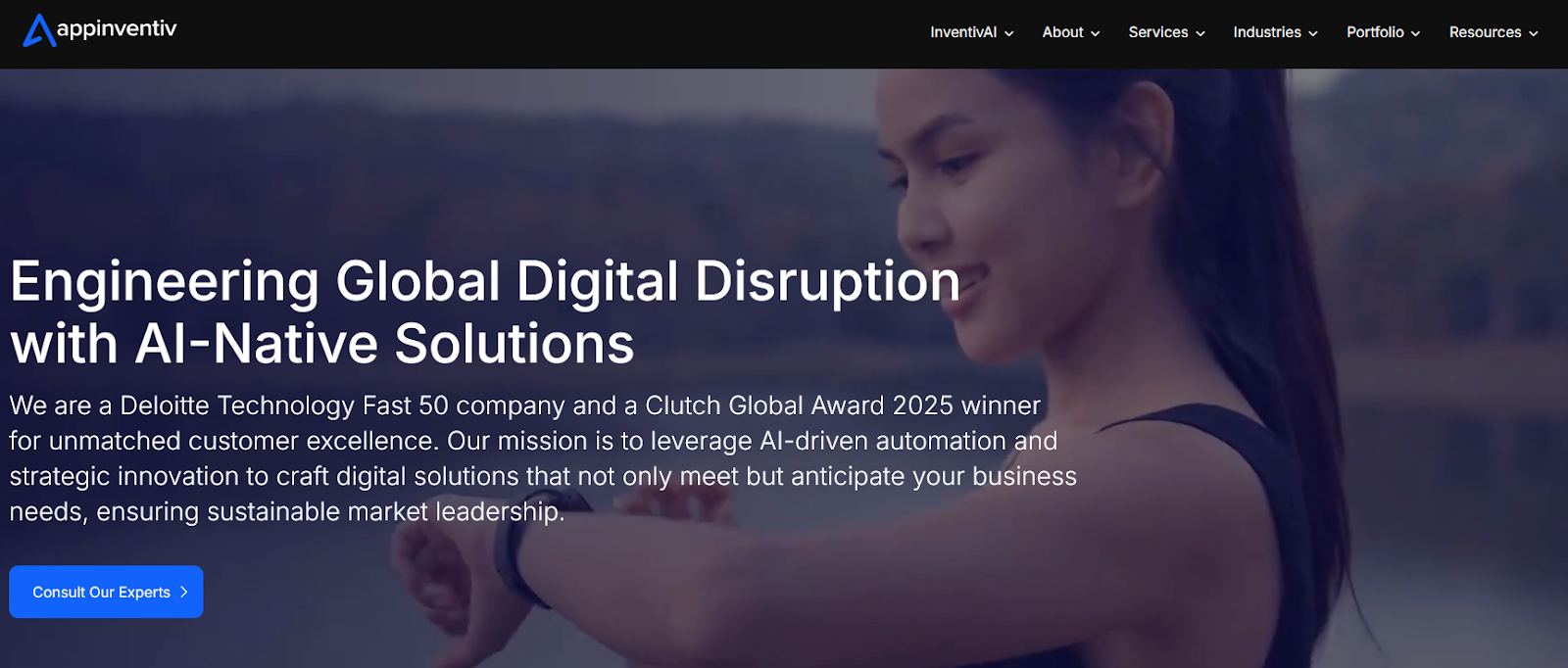
Appinventiv is a custom software development company specializing in end-to-end software development solutions. With a Clutch rating of 4.6 stars based on 89 reviews, Appinventiv has a largely positive reputation. This software development agency focuses on delivering innovative mobile applications and AI-powered solutions.
Core Services
Appinventiv offers three primary software development services:
- Custom Software Development (20%)
- AI Development (40%)
- Mobile App Development (40%)
Key Highlights
- Large team of 1,000 to 9,999 software developers
- Strong AI and machine learning capabilities
- Experience with both startups and enterprises
- Flexible engagement models
- Excellence in mobile application development
Approximately 70% of feedback highlights their strengths in project management, flexibility, plus technical expertise. Their minimum project size of $50,000 makes them suitable for mid to large-scale software development projects.
7. Arcanys
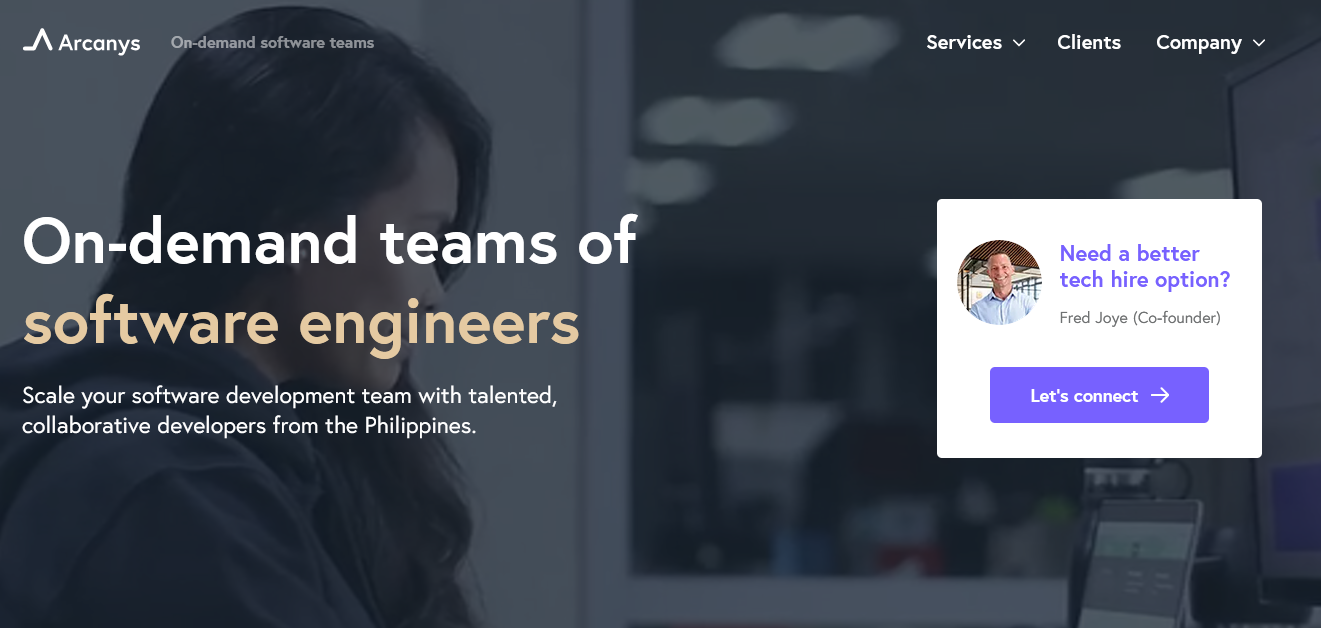
Arcanys offers full-stack software development and custom software creation, providing solutions meticulously tailored to meet the needs of various industries. With a perfect 5.0-star rating based on 25 reviews, Arcanys has earned a reputation for excellence.
Core Services
Arcanys focuses on three main areas:
- Custom Software Development (40%)
- Web Development (30%)
- AI Development (20%)
- Plus one additional service line
Key Highlights
- Long-term partnership approach
- Strong emphasis on code quality and best practices
- Transparent communication throughout development
- Seamless integration into existing workflows
- Expertise in developing software for complex business requirements
Arcanys' team of 250 to 999 software developers provides balance between personalized service and scalability. With a minimum project size of $100,000 and hourly rates of $25 to $49, they cater to enterprise clients.
8. VT Digital

Based in Sydney, Australia, VT Digital is a software development company that specializes in creating tailored, AI-enhanced software solutions. With a perfect 5.0-star rating based on 25 reviews, VT Digital has proven its excellence as a web development company and software development agency.
Core Services
VT Digital offers a balanced service portfolio of custom software development services:
- Custom Software Development (20%)
- Mobile App Development (30%)
- Web Development (20%)
- Plus 3 additional services including data analytics
Key Highlights
- Deep expertise in financial services industry
- Strong focus on compliance and regulatory requirements
- AI-enhanced solutions improving user engagement
- Local Sydney presence with global team capabilities
- Excellence in website development and web application development
VT Digital's team of 10 to 49 software developers ensures personalized attention. With a minimum project size of just $1,000 and hourly rates of $50 to $99, they accommodate projects of all sizes.
9. Hiteshi

Hiteshi is a bespoke software development company specializing in custom software creation plus full-stack development. Based in Sydney, Australia, Hiteshi has earned a perfect 5.0-star rating based on 27 reviews.
Core Services
Hiteshi focuses primarily on two areas:
- Custom Software Development (30%)
- AI Development (70%)
Key Highlights
- Heavy focus on artificial intelligence and machine learning
- Deliver projects ahead of schedule
- Strong emphasis on budget adherence
- Excellent value for money
- Expertise in delivering cutting edge software solutions
Hiteshi's team of 50 to 249 software developers provides the right mix of expertise and personalized service. With a minimum project size of $5,000 and hourly rates under $25, they offer exceptional value for AI development projects.
10. Appello Software
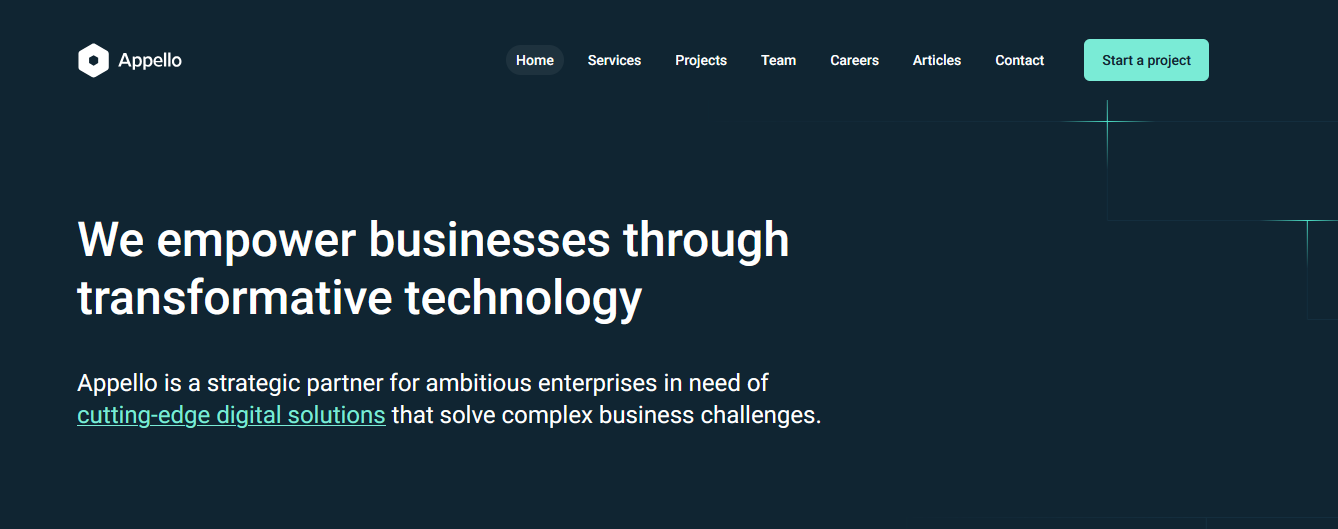
Appello Software is a custom software development company based in Sydney, Australia, specializing in tailored software development solutions, including mobile app development, web-based platforms, plus branding. With a Clutch rating of 4.9 stars based on 33 reviews, Appello has earned strong client satisfaction.
Core Services
Appello focuses heavily on mobile solutions:
- Custom Software Development (35%)
- Mobile App Development (55%)
- Web Development (10%)
Key Highlights
- Specializes in healthcare and fintech industries
- Strong UI/UX design capabilities including custom web design
- Transparent communication and project management
- Local Sydney presence ensures cultural alignment
- Excellence in mobile applications development
Appello Software tailors software solutions and mobile apps for industries such as healthcare and fintech. Their team of 50 to 249 software developers provides focused expertise. With a minimum project size of $50,000 and hourly rates of $100 to $149, they cater to clients valuing premium quality.
11. StepInsight

StepInsight is a custom software development company based in Sydney, Australia, known for expertise in bespoke software solutions. They focus on tailored software development plus end-to-end software engineering services. With a Clutch rating of 4.9 stars based on 11 reviews, StepInsight has built a solid reputation.
Core Services
StepInsight offers a balanced portfolio of software development services:
- Custom Software Development (40%)
- Mobile App Development (30%)
- AI Development (15%)
- Plus one additional service line
Key Highlights
- Strong technical proficiency across multiple platforms
- Client-focused approach with regular updates
- Timely delivery and adherence to budgets
- End-to-end software engineering services
- Proven ability to deliver solutions that meet business objectives
StepInsight's team of 10 to 49 software developers ensures personalized attention to every project. With a minimum project size of $25,000 and hourly rates of $50 to $99, they serve mid-market clients seeking technology solutions.
12. Tech Exactly

Tech Exactly is a custom software development company specializing in tailored and end-to-end software solutions. Based in Kolkata, India, Tech Exactly serves clients globally, including Sydney. With a Clutch rating of 4.9 stars based on 25 reviews, they have earned strong client trust.
Core Services
Tech Exactly focuses on mobile solutions and software development services:
- Custom Software Development (10%)
- Mobile App Development (50%)
- AI Consulting (10%)
- Plus 3 additional services
Key Highlights
- Strong mobile app development capabilities
- Exceptional communication and milestone tracking
- Adaptability to changing project requirements
- Cost-effective pricing model
- Excellence in mobile applications and mobile application development
Tech Exactly's team of 50 to 249 software developers provides the scale needed for diverse projects. With a minimum project size of $5,000 and hourly rates under $25, they offer excellent value for app development.
13. Offshorly
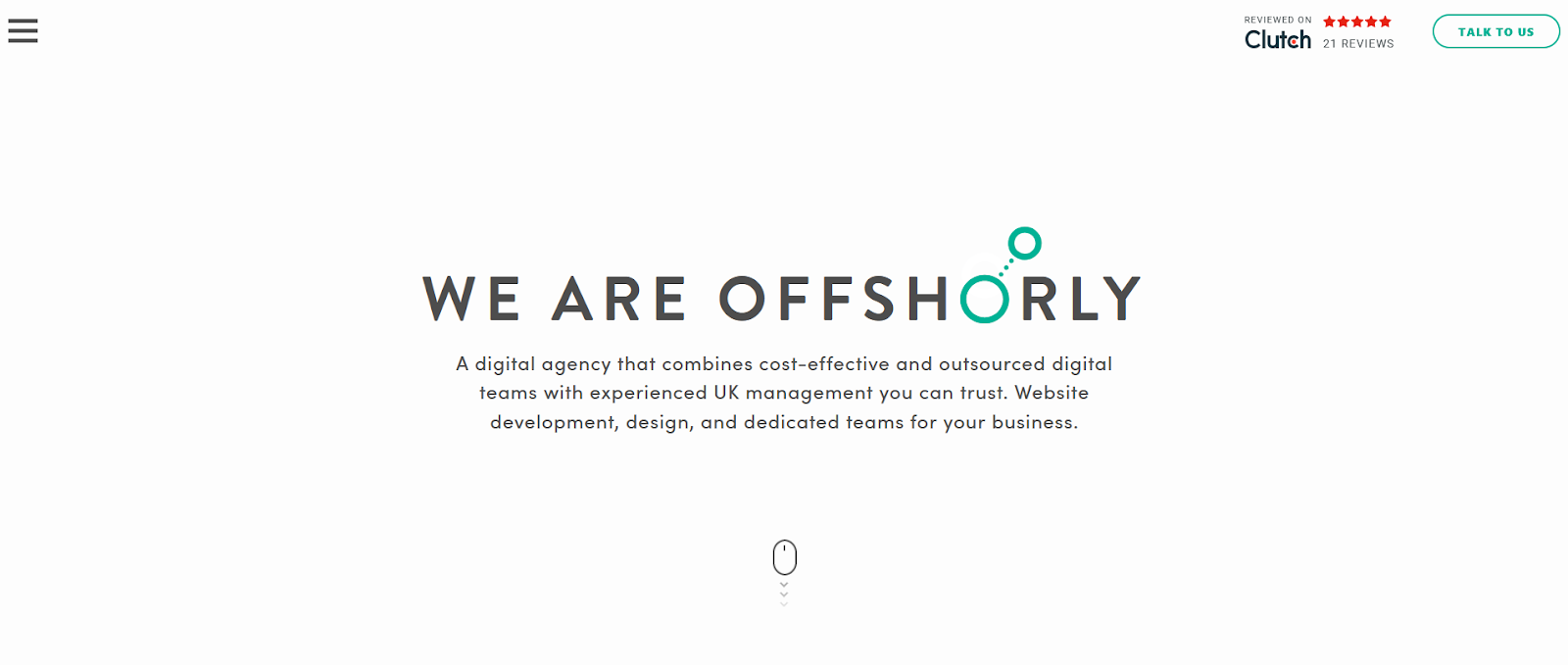
Offshorly is a custom software development company specializing in bespoke software creation plus end-to-end development solutions. With a Clutch rating of 4.9 stars based on 21 reviews, Offshorly has achieved a 100% positive feedback rate.
Core Services
Offshorly offers diverse custom software development services:
- Custom Software Development (20%)
- AI Development (20%)
- Web Design (15%)
- Plus 4 additional services including website development
Key Highlights
- Acts as an extension of your internal team
- Proactive approach to problem-solving
- High-quality deliverables consistently
- Strong commitment to client values
- Skilled at delivering tailored solutions across industries
Offshorly's team of 50 to 249 software developers ensures personalized service. With a minimum project size of $5,000 and hourly rates under $25, they provide cost-effective digital solutions for businesses of all sizes.
14. Sentia

Sentia is a custom software development company based in Sydney, Australia, offering tailored and end-to-end software solutions. With a Clutch rating of 4.8 stars based on 6 reviews, Sentia has built a reputation for excellence as both a software development agency and web development company.
Core Services
Sentia offers a balanced portfolio of software development services:
- Custom Software Development (20%)
- Mobile App Development (25%)
- Web Development (25%)
- Plus 3 additional services including web application development
Key Highlights
- Deep understanding of business objectives
- Strong technical expertise across multiple platforms
- Adherence to timelines and budgets
- Ability to deliver scalable solutions
- Excellence in website development and custom web design
Sentia's team of 10 to 49 software developers provides focused attention. With a minimum project size of $25,000 and hourly rates of $150 to $199, they cater to clients valuing premium expertise.
15. Quickworks
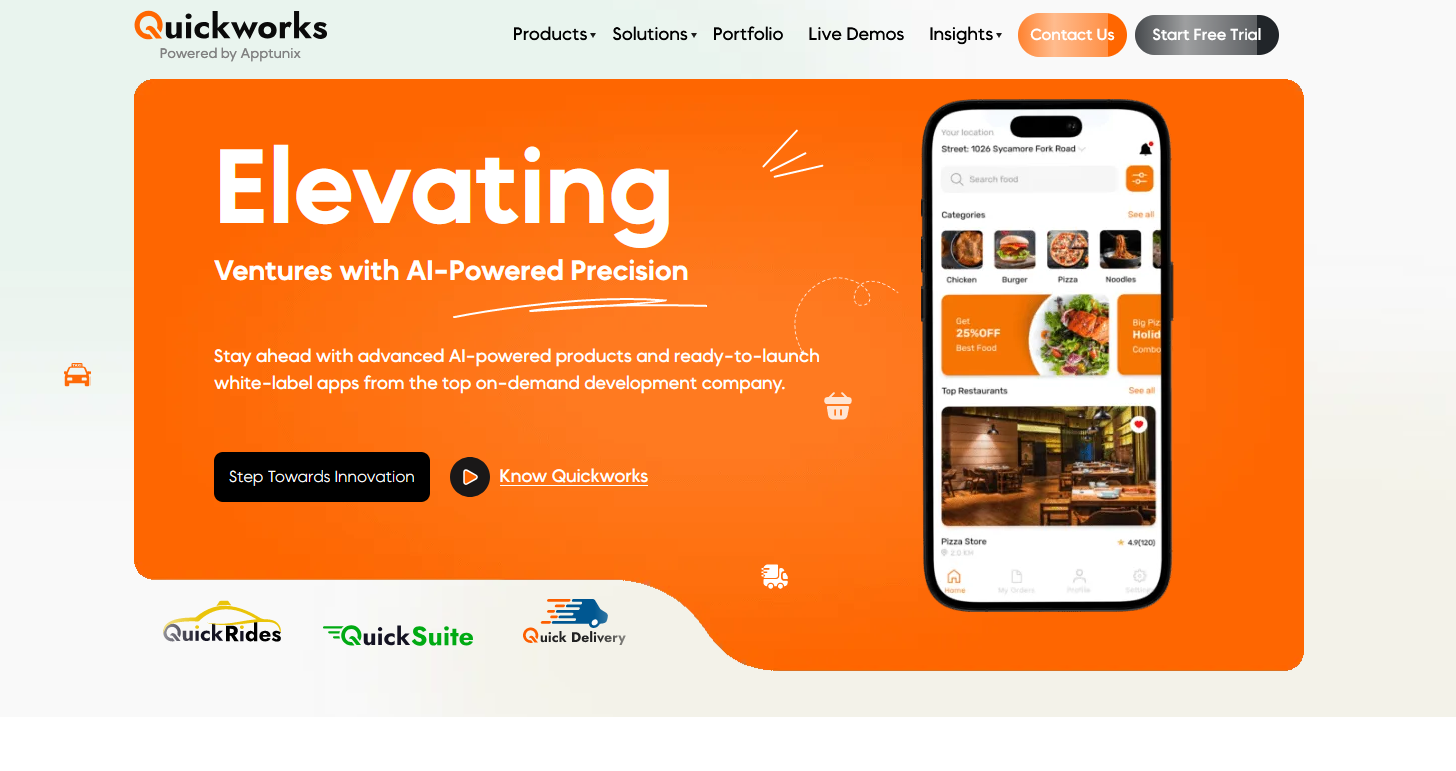
Quickworks specializes in mobile software development for iOS and Android, focusing on delivering ready-to-deploy, white-labeled platforms. Built with scalability, speed, plus simplicity in mind, Quickworks offers pre-built yet customizable tech stack.
Core Services
Quickworks offers specialized solutions:
- White-Label Apps: Prebuilt solutions for food, grocery, taxi, and fleet management apps
- SaaS Integration: AI-powered, customizable apps that can launch in weeks
- iPaaS/Workflow Automation: Drag-and-drop enterprise integration services platform with 1,500 plus pre-integrations
- Post-Launch Support: Regular updates, customer support, and feature enhancements
Key Highlights
- Deep domain expertise in on-demand platforms
- Affordable pricing without compromising quality
- Streamlined development approach using agile methodologies
- Exceptional post-launch support and updates
- Leading provider in white-label mobile applications
Quickworks specializes in mobile software development, building ready-to-deploy iOS and Android app development solutions that are white-labeled and fully configurable. Their plug-and-play architecture reduces development time by up to 70%, helping businesses launch within weeks. Their platforms are backed by robust APIs, high-level security, plus flexible UI modules.
Now that you have discovered the top software development companies in Sydney, let us dig deeper. How do you actually choose the right one? Because not every great name will be the right fit for your business. Here is what to consider before making your move.
Why Choose the Best Software Development Companies in Sydney?
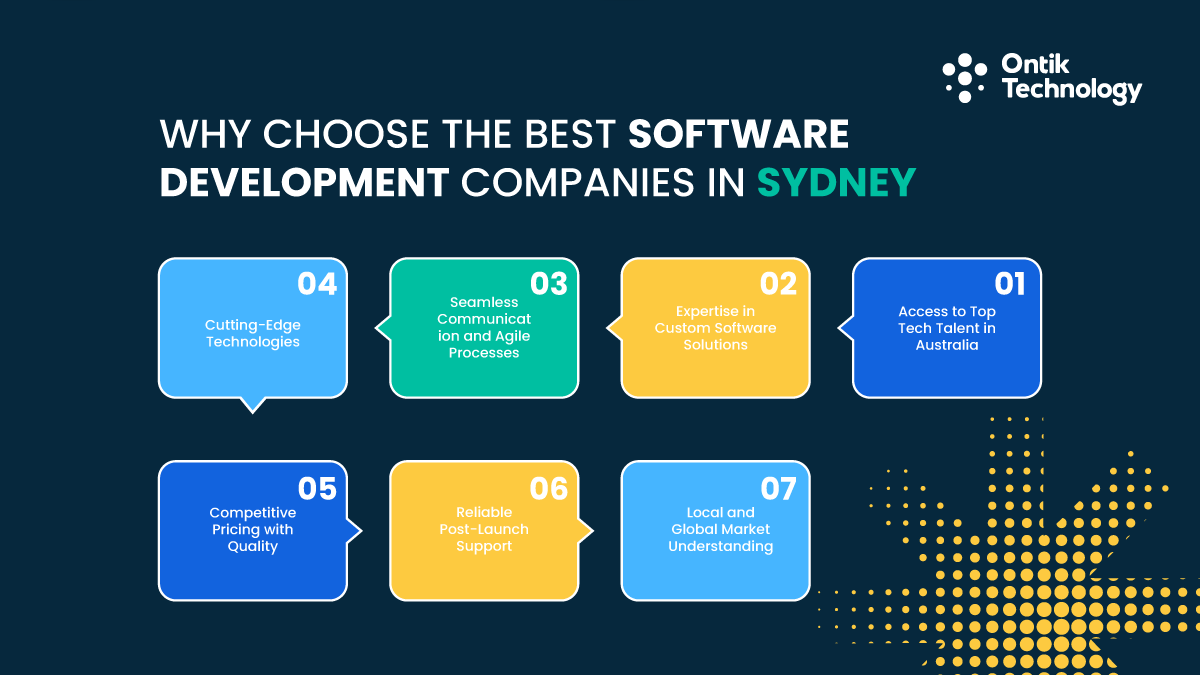
Collaborating with the right software development company in Sydney is crucial for business success. Whether you are a startup or enterprise, finding the right digital partner outlines your vision. Sydney is emerging as a powerhouse for next-gen software companies bringing real value.
Access to Top Tech Talent in Australia
Sydney hosts skilled software developers, software engineers, mobile developers, UI/UX designers, plus product strategists. These software developers in Sydney bring expertise across multiple technologies and frameworks.
Many top software companies in Sydney and IT companies in Sydney, Australia have major offices here, giving you access to concentrated tech talent. The collaborative environment among software developers in Sydney fosters innovation and knowledge sharing.
These professionals stay current with mobile software development trends. Government IT initiatives support STEM education, creating a pipeline of qualified software developers ready to tackle real business challenges.
Expertise in Custom Software Solutions
A custom software development company in Sydney builds platforms tailored for your goals and workflows. Custom software development improves efficiency and eliminates operational inefficiencies. Sydney firms deliver highly scalable systems, whether SaaS products or on-demand apps. Custom software solutions provide tailored solutions that give you competitive advantages through unique features aligned with your business vision and needs.
Seamless Communication and Agile Processes
Sydney software companies use Agile for faster, transparent custom development (market research, business analysis, development, deployment, maintenance). Time-zone alignment is beneficial. Agile's iterative development, cross-functional collaboration, and user stories define scope and functionality. Effective communication is key; scaling requires strategy to maintain efficiency and productivity.
Cutting-Edge Technologies
Sydney's innovation-led software ecosystem leverages cutting-edge tools like Flutter and React Native for cross-platform mobile apps, and modern web frameworks for faster delivery. Developers use advanced frameworks for robust systems.
DevOps improves collaboration, while cloud solutions boost scalability and performance. Business intelligence and data analytics enable data-driven decisions.
Competitive Pricing with Quality
While Sydney is not the cheapest market, the cost-to-quality ratio is outstanding. Firms offer flexible pricing: fixed-cost packages to dedicated teams. Software development costs range from $20,000 for MVPs to $5 million for full products. A Minimum Viable Product tests market viability before full investment.
Reliable Post-Launch Support
Sydney-based firms offer maintenance, monitoring, bug fixes, plus upgrades. Ongoing maintenance keeps software running smoothly. Regular feedback loops ensure software meets user needs. Custom software development can lead to better user experiences by focusing on user-centric design principles.
Local and Global Market Understanding
These app development companies in Sydney grasp compliance, user behavior, plus Australian regulations. Companies in Sydney may have better insight into the local business landscape and specific customer expectations. Adhering to Australian Privacy Principles (APPs) and Notifiable Data Breaches (NDB) scheme is crucial. This local insight combined with global delivery makes them ideal partners.
Ready to find your development partner? Let us explore the top 15 best software development companies in Sydney.
Sydney's IT Landscape: A Hub for Innovation
Sydney has emerged as Australia's premier destination for technology services. The city hosts numerous top IT companies in Sydney alongside innovative small IT companies in Sydney that deliver specialized solutions. Whether you're searching for top tech companies to work for in Sydney or seeking IT Services Companies in Sydney for your project, the city's ecosystem supports every need.
This comprehensive list of IT companies in Sydney represents the top 10 IT companies in Sydney and beyond, showcasing firms that excel in custom software and app developers Sydney services. These top software companies in Sydney and best software development companies in Sydney Australia have established proven track records across industries. Many leading providers in Sydney's software development agency landscape offer comprehensive services from ideation to deployment.
Parameters to Choose the Best Software Development Company in Sydney
Selecting the best software development company in Sydney is a high-stakes decision for any business, big or small. The right partner brings more than just code to the table. They bring strategy, support, plus long-term value. Here are the most important parameters to guide your decision.
Experience and Industry Expertise
Start by checking how long the company has been operating. Longevity reflects credibility and consistent delivery. Look for industry experience in your specific sector, as healthcare apps differ vastly from retail platforms.
Check for years in business, successful project count, industry-specific case studies, client testimonials from similar sectors, awards and recognitions, plus partnerships with technology leaders like Microsoft Gold Partner status. Top software development companies in Sydney showcase case studies demonstrating their domain expertise. Experienced software developers offer deep insights, better workflows, plus avoid rookie mistakes. Top software developers in Sydney understand how to align technology with your business vision.
Range of Services Offered
Top Sydney custom software developers provide full-cycle services, including ideation, maintenance, and essential offerings like mobile app, web, and backend development, along with custom web design and application capabilities. This comprehensive approach eliminates the need for multiple vendors.
Full-cycle development includes business analysis, user stories, development, deployment, plus ongoing maintenance. A leading provider should deliver solutions across all platforms and technologies.
Tech Stack and Tools
Modern problems need modern tools. Check what programming languages, frameworks, plus technologies the company uses. Sydney's best mobile software development companies master Flutter, Kotlin, Swift, React Native, plus more.
Key technologies include frontend frameworks (React, Angular, Vue.js), mobile platforms (Flutter, React Native, Swift, Kotlin), backend systems (Node.js, Python, Java, .NET), cloud services (AWS, Azure, Google Cloud), and emerging tech (AI/ML, Blockchain, IoT, business intelligence and data analytics tools).
The technology stack should align with your project requirements plus future scalability needs. Top software developers should be proficient in multiple tech stacks and cutting edge technologies.
Portfolio and Case Studies
Always review a company's past projects. This shows their technical skills, creativity, plus ability to solve real business challenges. Look beyond surface design. Examine user reviews, performance improvements, or revenue results tied to their projects. Client reviews often highlight the importance of communication and timely delivery in software development projects.
Client success stories reveal how the company approaches real business challenges and their ability to deliver solutions that drive business success. Look for examples of tailored software solutions that addressed specific client needs.
Client Testimonials and Reviews
Reviews can offer valuable insight into the company's professionalism, reliability, plus communication. Platforms like Clutch, GoodFirms, and Google Reviews are a good start. A great software development company in Sydney does not just deliver good products but builds lasting relationships.
Pay attention to patterns in reviews. If multiple clients mention excellent communication, that is a strong signal. If several mention delays, that is a red flag. Reviews from engineering firms and established businesses carry significant weight.
Development Approach and Methodology
The most successful software development companies in Australia often follow Agile or Scrum methodologies. These ensure faster iterations, real-time feedback, plus a lower chance of rework. A defined software delivery process builds transparency, accountability, plus trust.
Agile offers iterative development for flexible requirements, uses regular sprints for continuous progress, ensures transparent communication, allows quick adaptation to changing business needs, and fosters collaboration between the client and development team. DevOps enhances collaboration between development and operations through continuous integration and deployment.
Pricing Model and Cost Transparency
The software development cost in Sydney varies based on scope, tech stack, plus team structure. Make sure the company is upfront about pricing. Look for flexibility in pricing models: fixed-price, hourly, or dedicated team models. Remember, the cheapest option can become the costliest if it lacks quality or stability. Value for cost is more important than just low prices.
Support and Maintenance
Software development requires ongoing maintenance, not a one-time job. Leading Sydney software development companies provide flexible post-launch maintenance, including performance monitoring, bug fixes, and regular updates. Consistent feedback during development ensures solutions meet user needs.
Finding a software development company in Sydney that checks all these boxes is not easy, but it is worth the effort. For companies needing additional resources, consider exploring dedicated development team options.
What Are the Software Development Costs in Australia?
Understanding software development cost in Australia, particularly in Sydney, is essential for smart budgeting. Projects range from AUD 10,000 to AUD 100,000 plus, depending on numerous factors.
| Project Type | Complexity Level | Estimated Cost (AUD) |
|---|---|---|
| Basic mobile app (iOS + Android) | Low to Medium | 10,000 – 30,000+ |
| Hybrid cross-platform app (React Native) | Low to Medium | 10,000 – 30,000+ |
| E-commerce platform or marketplace | Medium | 30,000 – 50,000+ |
| Enterprise software (CRM, ERP) | High | 50,000 – 90,000+ |
| AI/ML-driven app or automation tool | High | 50,000 – 100,000+ |
| Blockchain or Web3 platform | Very High | 100,000 – 130,000+ |
The cost of software development can range from $20,000 for a simple Minimum Viable Product to over $5 million for full product development. Simple software development projects typically take 10 to 12 weeks, while larger projects can take several months to a year.
Factors Influencing Cost
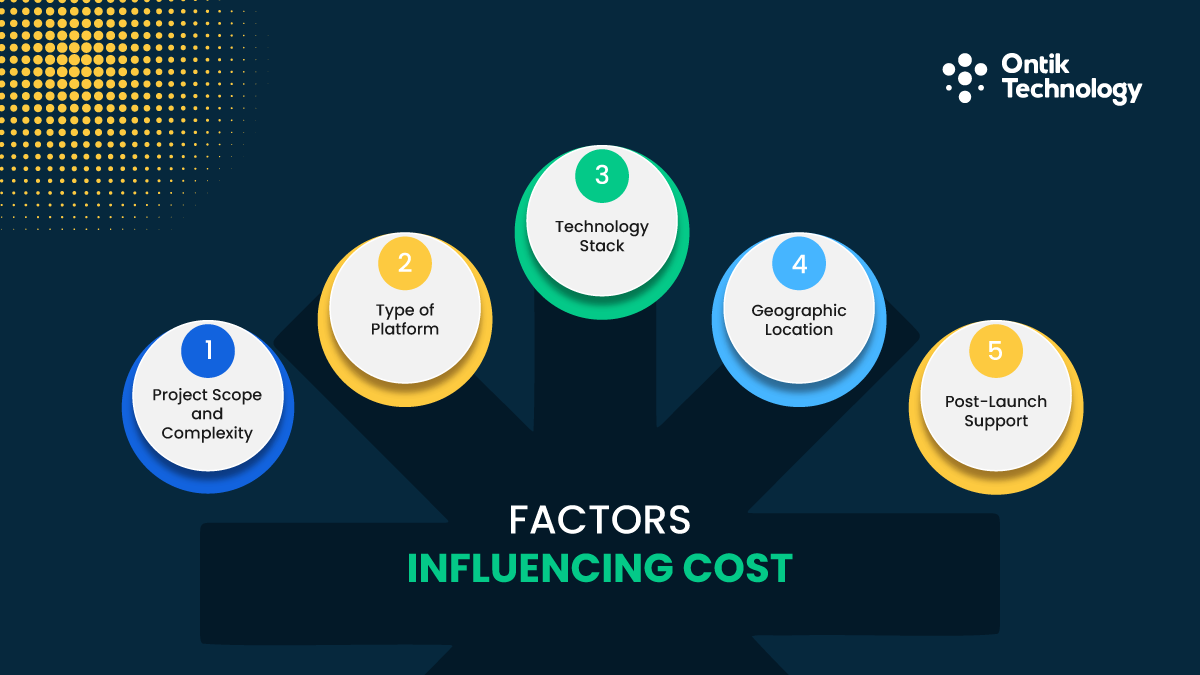
Project Scope and Complexity: Enterprise systems with user roles, analytics, plus integrations significantly increase software development costs in Sydney.
Type of Platform: Web development is often cost-effective. Native mobile apps for iOS and Android require separate builds, raising expenses. Hybrid solutions like React Native save time and money. Mobile application development costs vary based on platform choice.
Technology Stack: Standard stacks are affordable. New technologies like AI, blockchain, or IoT demand special skills with higher costs. Data analytics and business intelligence features add to the overall cost.
Geographic Location: Software developers in Sydney are more expensive than outsourcing teams. The pricing for software development services varies significantly based on whether the team is onshore or offshore.
Post-Launch Support: Ongoing maintenance typically costs 15 to 20% of the initial development budget annually.
A Comparative Overview of Sydney's Leading Software Development Companies
Choosing the right partner requires understanding what each company brings to the table. Here is a comparison of the top firms.
Team Size and Pricing
Small IT companies in Sydney (10 to 49 software developers) offer personalized attention plus flexibility, ideal for startups requiring close collaboration. Larger firms (1,000+ software developers) provide scalability plus diverse expertise for enterprise projects.
Budget-friendly options (under $25/hr) include Ontik Technology, TechnoYuga, Hiteshi, Tech Exactly, plus Offshorly. Mid-range options ($25 to $99/hr) include Simform, EB Pearls, Appinventiv, Arcanys, VT Digital, plus StepInsight. Premium options ($100 to $199/hr) include Appello Software and Sentia.
Specialization and Location
AI and machine learning specialists include Ontik Technology, Simform, Hiteshi, plus Innowise. Mobile app development leaders include EB Pearls, Tech Exactly, plus Appello Software. Healthcare and fintech experts include Appello Software, Innowise, plus VT Digital.
Web development company specialists include VT Digital, Sentia, and Arcanys, offering comprehensive website development and web application development services.
Sydney-based companies include VT Digital, Hiteshi, StepInsight, Appello Software, Sentia, plus EB Pearls, offering local insight plus cultural alignment. Global companies serving Sydney include Simform, Innowise, Appinventiv, Arcanys, TechnoYuga, Tech Exactly, Offshorly, plus Ontik Technology.
Companies with perfect 5.0-star ratings include TechnoYuga, EB Pearls, Arcanys, VT Digital, plus Hiteshi. Several software development companies in Sydney have experience working with startups and enterprises alike, providing tailored solutions to meet specific client needs with a strong focus on customer satisfaction and long-term partnerships.
Final Thoughts
Selecting the right Sydney software development partner is key to digital success, whether for a startup or an enterprise. Custom software drives business growth. Smart budgeting and a reliable partner accelerate scalability.
Sydney hosts top app development firms for diverse industries, from AI to enterprise solutions. To begin, define requirements, set a budget, and contact the best fit. Building an MVP minimizes risk and validates the concept.
The right company becomes a strategic partner, understanding your goals and providing the technical expertise to execute. Choose wisely and start building your future today.
FAQ's
What is the average cost of software development in Sydney?
The average software development cost in Sydney ranges from AUD 10,000 to AUD 100,000 plus, depending on project complexity. Simple mobile apps start around $10,000, while enterprise solutions can exceed $100,000. Factors like tech stack, team size, plus project scope all influence final costs.
How long does it take to build a custom software solution?
Simple software development projects typically take 10 to 12 weeks to complete. More complex enterprise applications can take several months to a year. The timeline depends on project requirements, team size, plus development methodology. Agile approaches often deliver faster results through iterative development.
Should I hire a local developer or outsource?
Local software development companies in Sydney offer better communication, cultural alignment, plus understanding of Australian regulations like the APPs and NDB scheme. However, offshore teams provide cost savings. Many businesses choose hybrid models that balance quality with budget. Consider your priorities: communication versus cost.
How do I verify a company's expertise?
Check their portfolio, case studies, and client testimonials (Clutch, Google Reviews). Request references. Inquire about their tech stack and development methods. Use a free consultation to assess communication and expertise. Look for industry recognition like Microsoft Gold Partner status.
